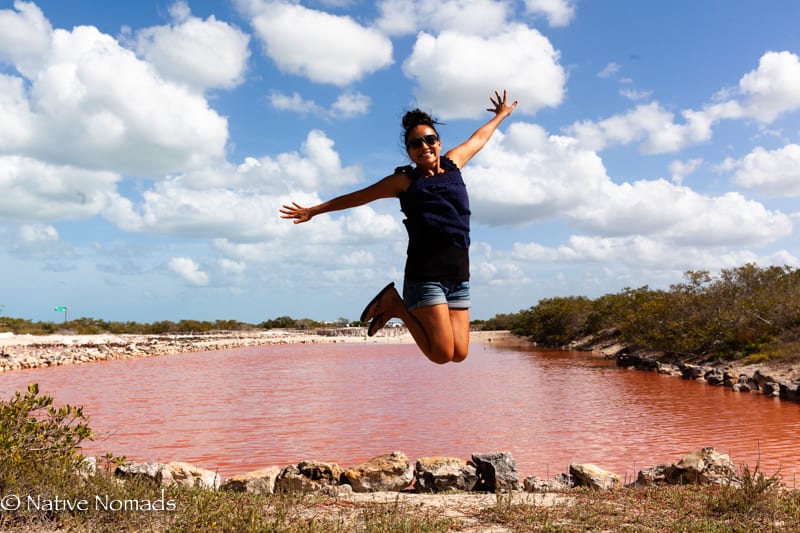Interested in our favorite day trips from Merida (Mexico)? Check out our latest blog post covering the top 8 places to see in a day. Merida has been our home base for the last year and a half so we took our time to curate the best of the best in this list for you. Check back often as we will be continuing to enhance this post as we discover more and more to do. Enjoy!!!
1. Homun Cenotes With a Local Maya Restaurant
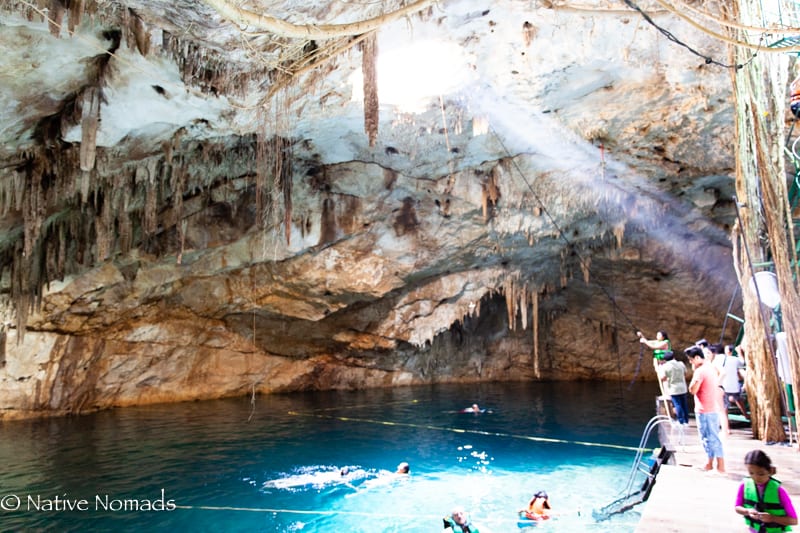
How to Get There:
Car/Rental Car: Always a great option if you want to have full control over where you want to go and have the flexibility of changing plans
57 minutes outside of Merida taking highway 180 East, you will go through a very charming village called Tahmek. Tahmek connects you with highway 60 to Hocaba – another very interesting Maya village. As you continue through this town you will run into Homun.
Bus: You can catch the bus from the Merida Centro bus station that will bring you to Homun. Terminal ADO Mérida TAME to Homun for $140 – $170 pesos (approximately $7-$8.50 USD): it takes a little longer with travel times ranging up to 1:45 minutes but sometimes it is worth not having to think about paying for and driving a car.
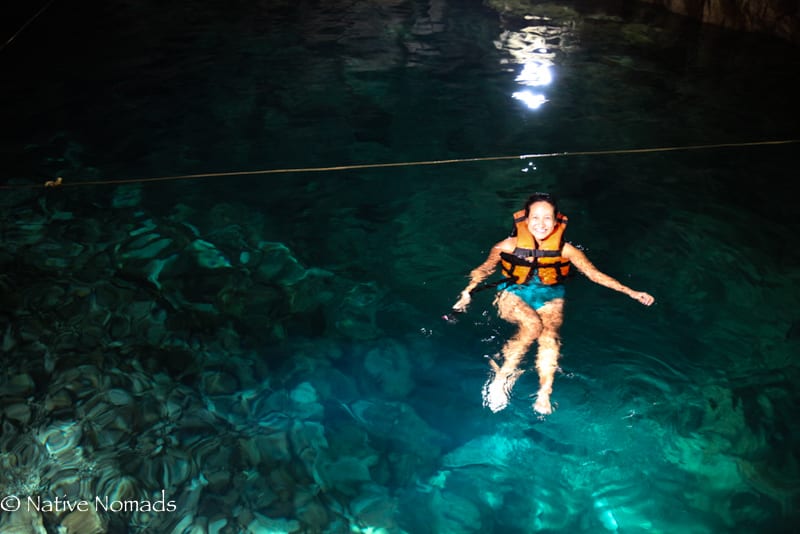
The Destination:
The area of Homun looks from the outside very similar to most of the Yucatan – a quaint little Maya village with a beautiful church and a tranquil town square. It’s what lies beneath the city that makes the area so exciting and why it makes our list of top day trips from Merida. Accessible from the outskirts of Homun, there is a system of underground rivers that connect throughout the entire Yucatan peninsula.
They call them cenotes (from the Maya word “dzonot”) and if you have ever experienced one there is nothing like it in the entire world. They were formed thousands of years ago after the Ice Age when limestone coral reefs that had initially been under the sea, ascended to become the land of what is now the Yucatan Peninsula. This limestone land filtered rainwater into its underground caves and tunnels, eventually collapsing at the top to expose the above sunlight to the natural clear water pools below. Some cenotes are more open air (meaning they look more like a lake or pond) and some are more cave like with only a tiny opening at the top.
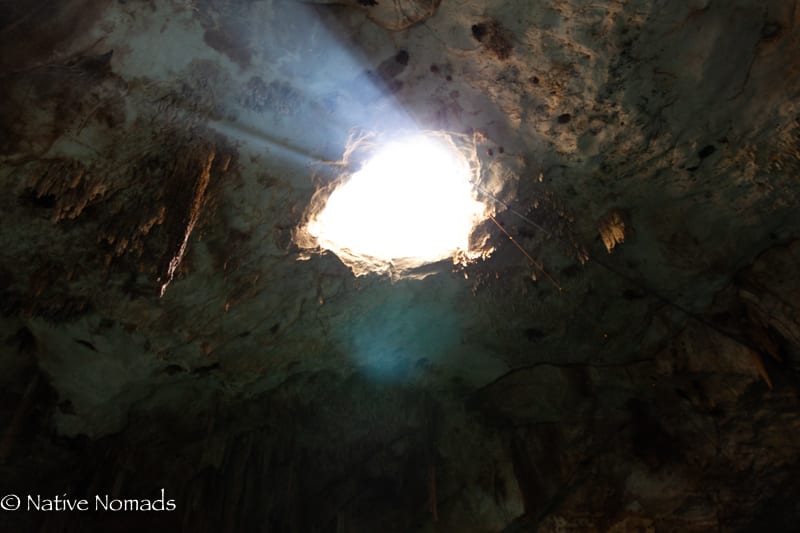
How to Get Around and What To Do Once You Are There:
Homun is well known for its cenotes and there are dozens that you can visit easily, but we highly recommend hiring a local guide that will either travel with you in your car or take you by moto-taxi, which is a blast. The cenotes are very accessible but it is easy to get turned around and drive aimless down one of the many unmarked dirt roads for quite a while.
Our Favorite Cenotes in Homun:
Cenote Canunchen
Grutas y Cenote La Candalaria
- Cenote Yaxbacaltun
- Cenote Hool Kosom
Cenote Canunchen
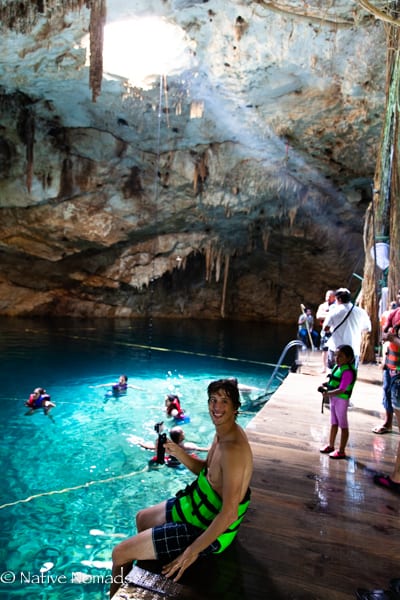
Grutas y Cenote La Candalaria
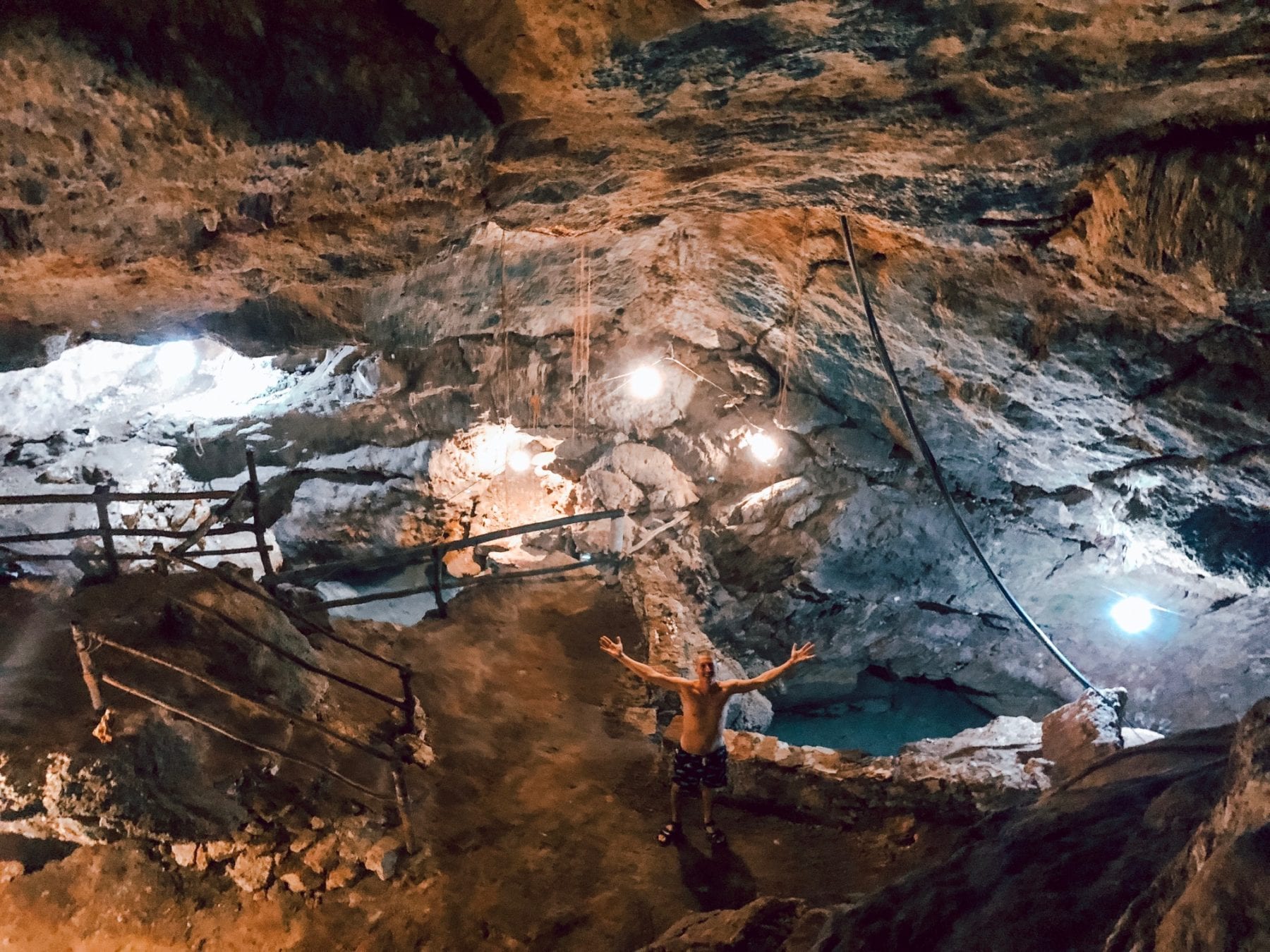

Cenote Yaxbacaltun
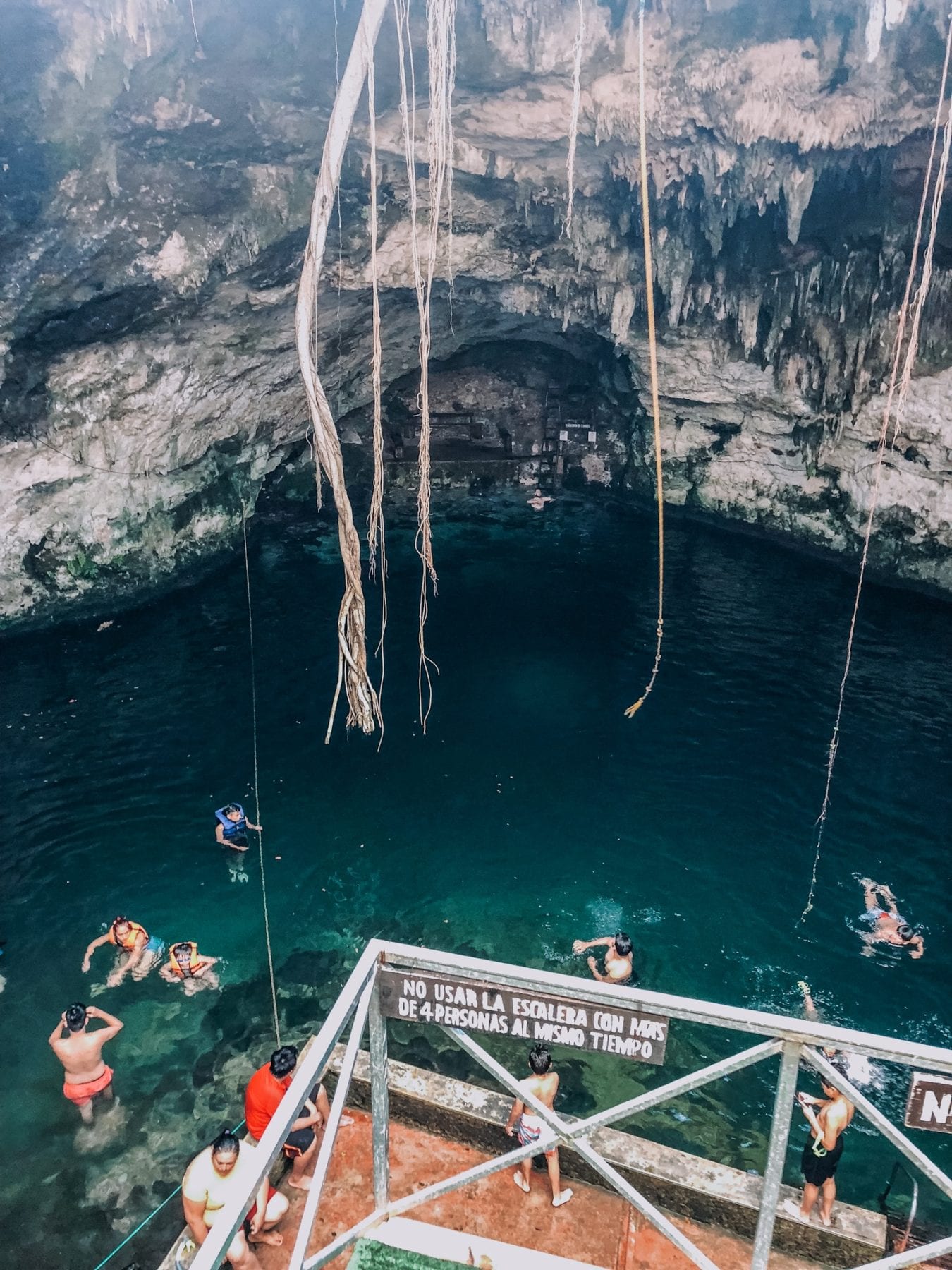
Cenote Hool Kosom
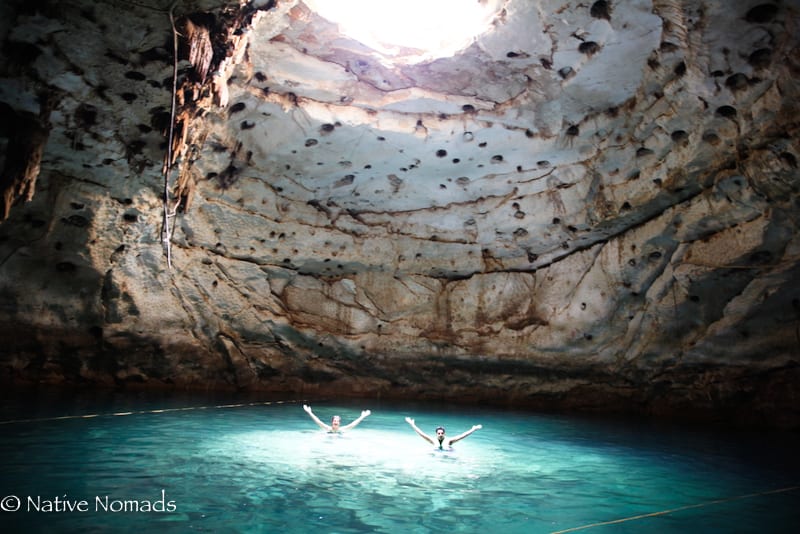
Local Maya Restaurant for Lunch
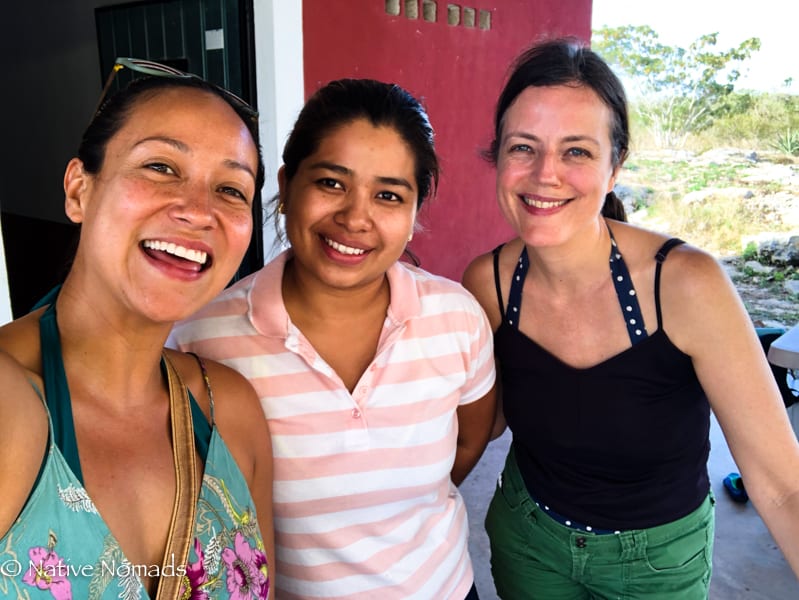
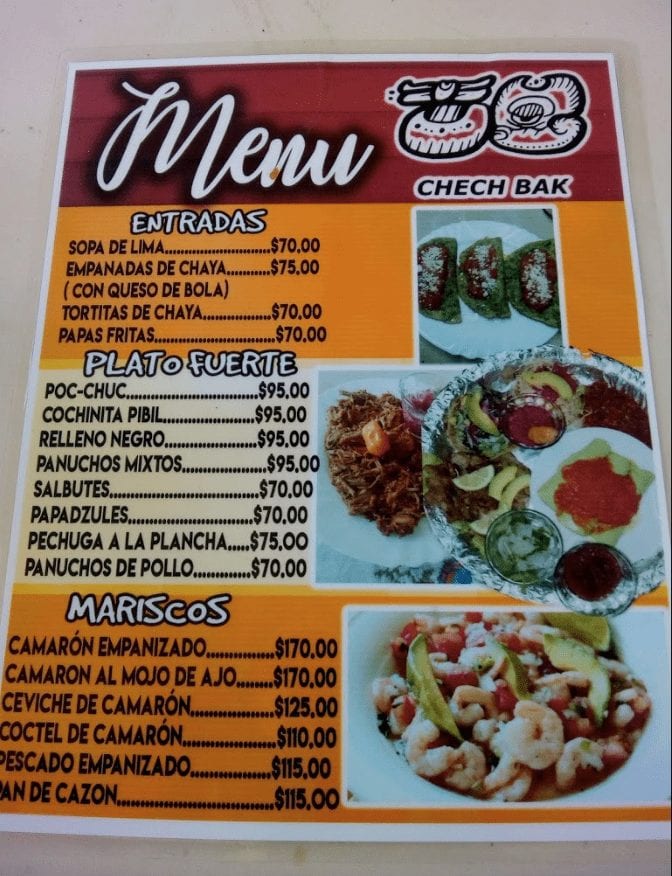
2. Uxmal and Chocolate Museum With Dinner at Temozon Hacienda:
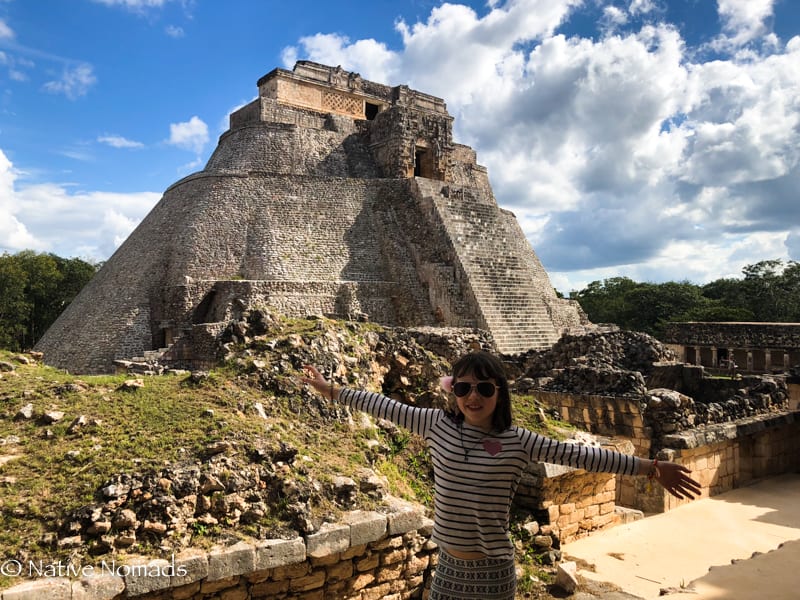
How to get there:
Car/Rental Car: Basically a straight shot south from Merida on Mexico 180 that connects with Mexico 261. This straight shot will run right into the Uxmal ruins.
Bus: Uxmal can be reached by bus from the Terminal TAME (Take the Sur Bus to Campeche that stops at Uxmal en-route)
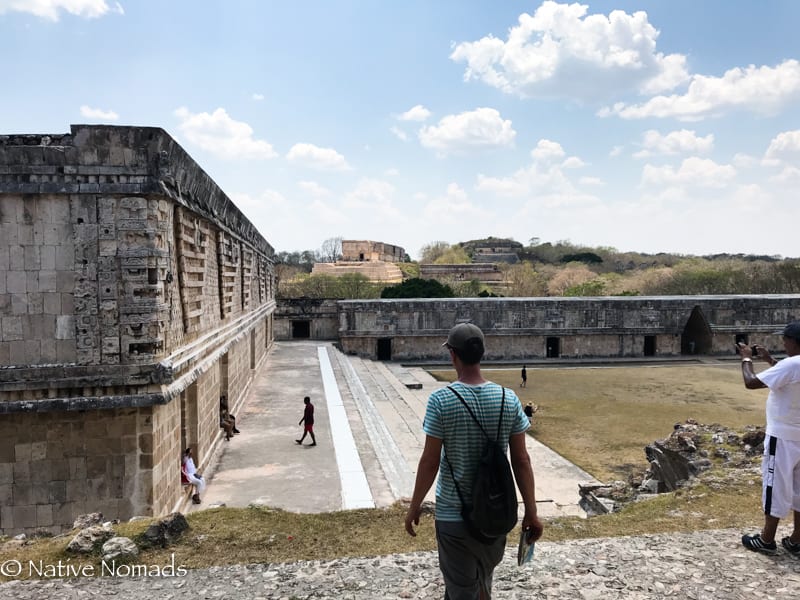
The Destination:
Uxmal is an expansive and well preserved Maya archeological ruin in the Yucatan. It is probably the most popular ruin other than Chichen Itza in the Yucatan peninsula. The ruins are said to be built by a wizard dwarf who created the project in a single day. When you first enter you cannot miss the large oval style Pyramid of the Magician, sitting in the middle of a field surrounded by houses for the administration that are perfectly preserved. You won’t be able to climb up this giant pyramid, but take some time to bask in its glory as you admire all of the classical Maya architectural genius. Depending on the time of the year you can witness bats that live in the buildings where hundreds of them have found a home in the cracks between the wooden supports above the doors.

Beyond the pyramid, you will find the Nunnery – a four-sided courtyard surrounded by carved buildings that all have a story of why they are carved in that manner. As you go down a slight decline you cross a valley of ruins, including a medium-sized ballcourt, meant for a serious, ceremonial and sacrificial rubber ball game, which finally leads up a flight of stone steps to a platform where you will find the enormous Governor’s Palace. Hopefully, the temperature has not drained you of all of your energy as you make the climb.
You are able to completely walk in and around this building which gives you a view of the entire valley and the Magician’s Pyramid on the opposite side. Behind the palace, there is a second Pyramid that you are allowed to climb to the top, which is becoming rarer in these archaeological sites in order to prevent further wear and tear and vandalism. It is completely awe-inspiring to climb the same stairs the ancient Maya used for generations, imagining the world they inhabited centuries ago. We love this place and find ourselves drawn back with almost every friend that visits.
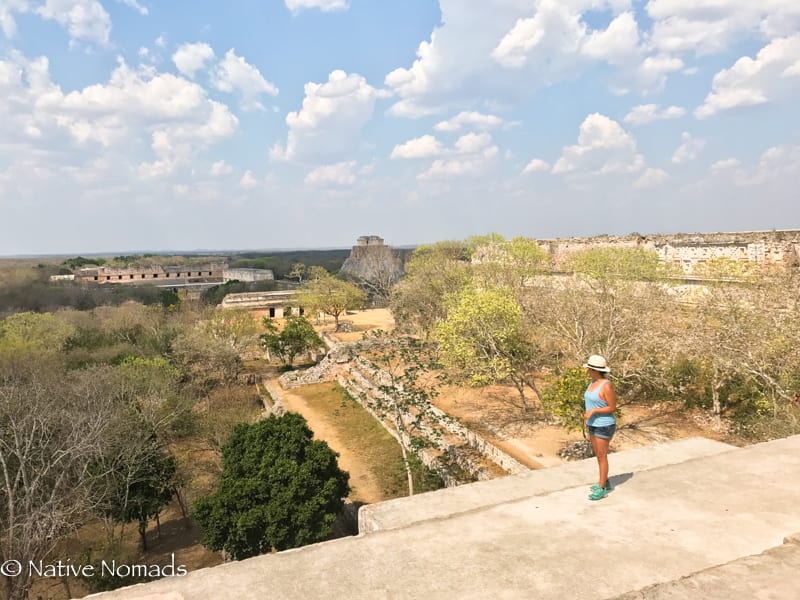
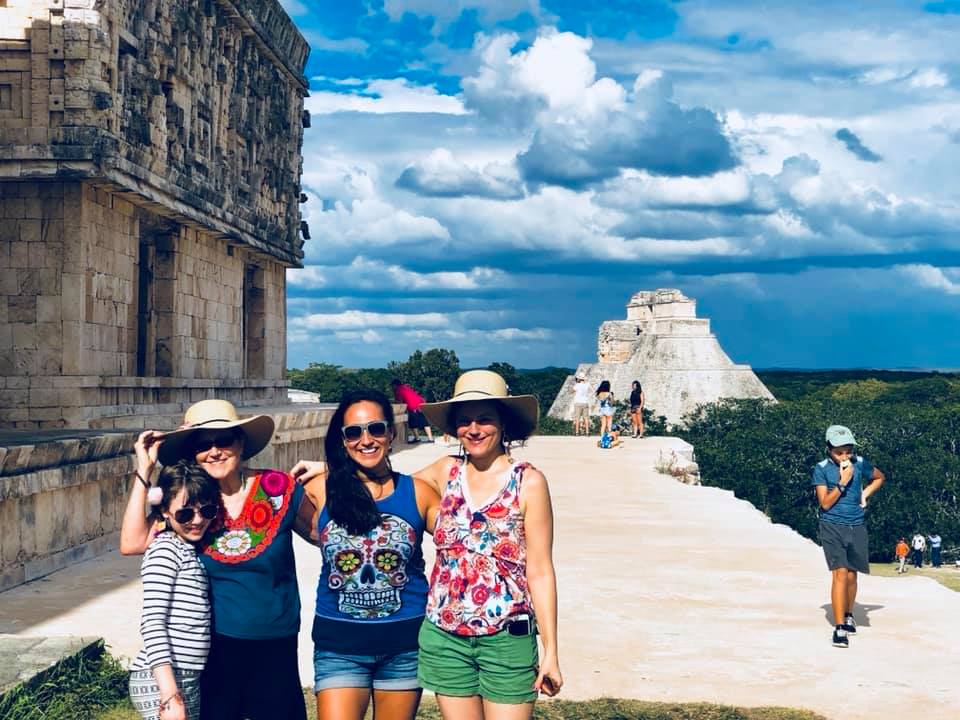


How to Get Around and What To Do Once You Are There:
Walking is the only form of transportation in the Uxmal Archaeological Ruins and the Chocolate Museum across the highway; the paths are well maintained, and in the Chocolate Museum, the traditional thatch houses with exhibits are kept nice and clean for exploring.
The Chocolate Museum:
Down the road from Uxmal is the Chocolate Museum. If you like chocolate (or love it as we do) and want to know everything about the history of the Maya and their relationship with chocolate then this is a must go. It’s no mystery that chocolate was extremely valuable to ancient Maya as they (and the Aztecs) were the first humans to cultivate the crop and even used it as a form of currency. After processing the cacao beans into a paste they would mix it with spices, vanilla, chiles and water, creating a delicious chocolate drink that was known for its magical, ceremonial and health properties.
We went to the museum after a long hot day of touring around the ruins and the iced chocolate drink from the cart at the beginning of the path was possibly the best thing we have ever tasted in our life. The Chocolate Museum preserves a large piece of land that is landscaped with native plants from the Yucatan with small exhibits in traditional Maya thatched-roof huts, as you walk through the winding pathway. At some point in your tour, check out the traditional Maya chocolate ceremony (offered every half hour) where Maya shamans dressed in white robes bless the four directions and thank the ancient gods for the blessings of chocolate.
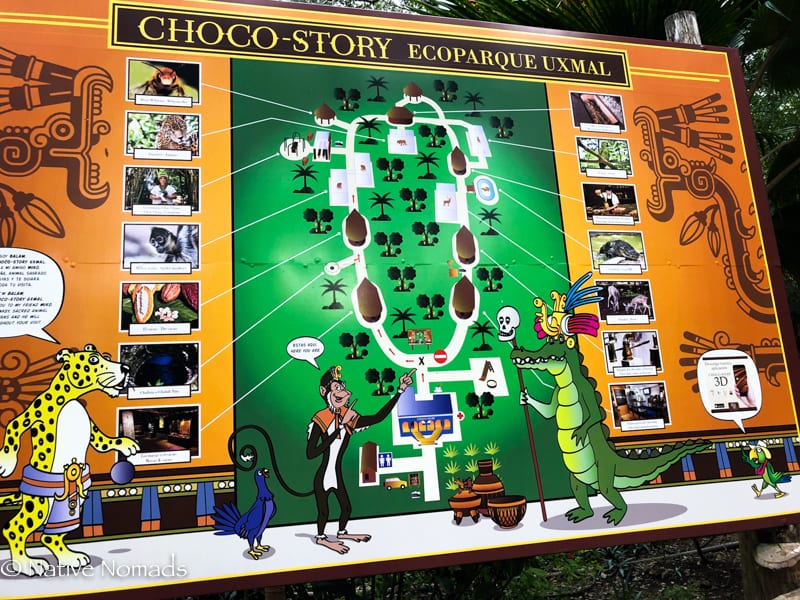
The Chocolate Tastings
Drinking chocolate in the Maya tradition was a first for us. As you enter one of the larger Maya traditional buildings toward the end of the tour, they have rows of seats with a display in the center. A woman first explained why chocolate was so important to the Maya people and then showed the steps of the process, from harvesting the cacao beans from the pods in the trees, to turning it into the delicious drink that was their favorite. Again, Maya people traditionally drink the chocolate with chili pepper (among other ingredients) which gives it a very spicy taste and also gives the consumer an immediate rush of energy. We felt after one sip that we could run a marathon. It was a unique experience that is a must if you are in the Uxmal area.
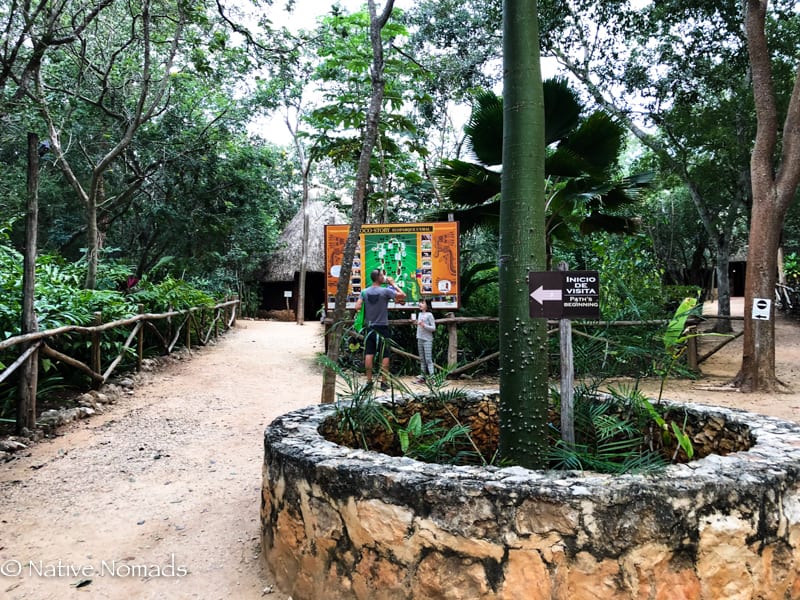
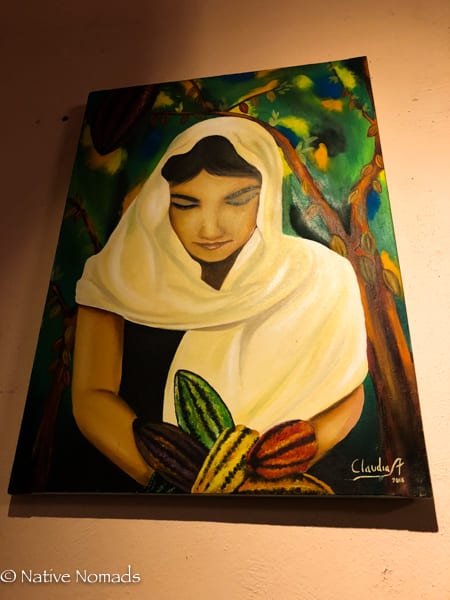
Travel Tip:
Get to the Uxmal Archaeological Site early and make sure to bring a hat and plenty of water; the area gets hot or extremely hot depending on the time of the year. Make sure to wear shoes that offer a lot of support so that when it comes time to climb the stairs you will have no problems.
Visit the Chocolate Museum after the Uxmal Archaeological Site so that you are in the shade and walking in a small, flat area during the hottest part of the time. Find a cenote on the way back to Merida to cool off afterward, if you are up for it too!
Fun Fact:
Look out for countless masks of the Maya rain god Chac who has the curly nose and toothy mouth throughout all of the architectural facades in Uxmal. Chac was the main honored god in Uxmal, since there were no natural water sources like the cenotes of other Maya cities and they had to collect their rainwater in man-made cisterns.
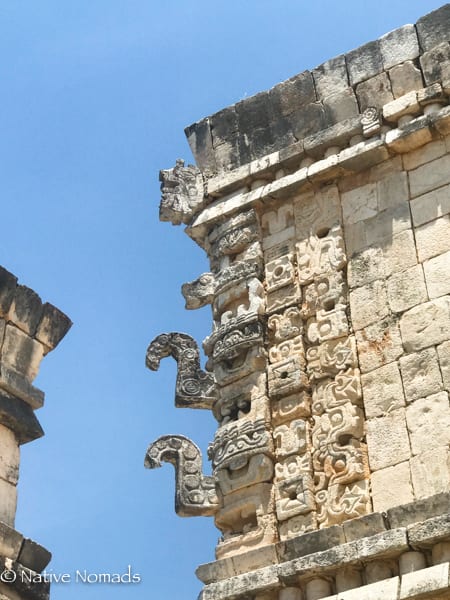
3. Celestun Beach with Mangrove Boat Tour:
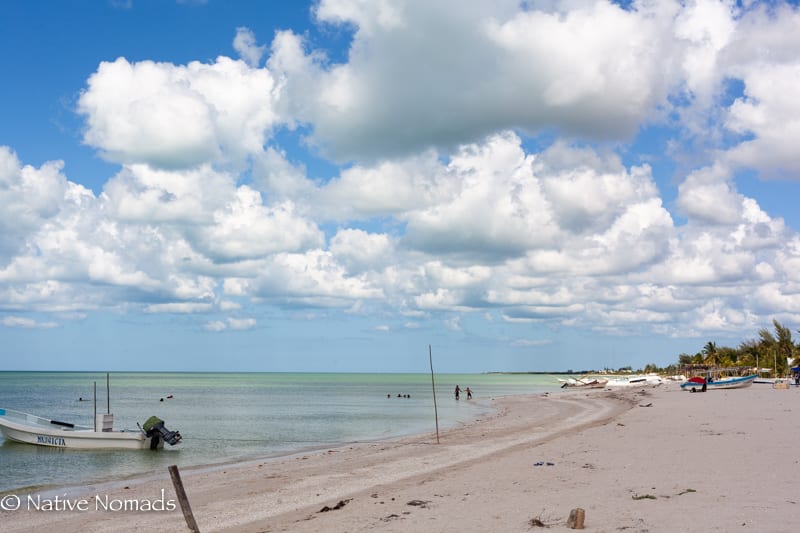
How to get there:
A rental car: is a great option for this day trip from Merida. It’s not a long trip and as you get closer to the mangroves you will start to see flock after flock of tropical birds flying overhead. A rental car gives you the option of slamming on the breaks and experiencing the wonder of flight without flying yourself.
Bus: The bus from Merida to Celestun leaves hourly from Merida’s Noreste bus station terminal on Calle 50 and 67 in Centro. At the time of this writing it costs just 93 pesos and within 1 hour and 30 minutes you can be in Celestun without worrying about renting or parking a car.
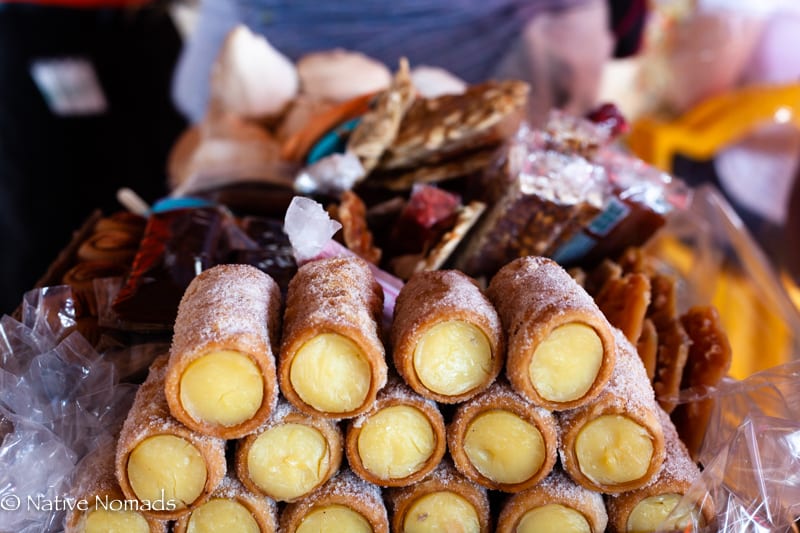
The Destination:
Celestun is a quiet beach town. At first glance, it boasts a small town plaza that is beautifully surrounded by restaurants, houses and a couple of boutique hotels. It has a really nice beach with white sand; perfect for laying out and cooling off with the turquoise green Gulf Sea waters during a typical hot day. It is easy to find inexpensive, delicious palapa style seafood restaurants along the beach serving up tasty, fresh fish dishes and cold beer, in between swimming sessions.
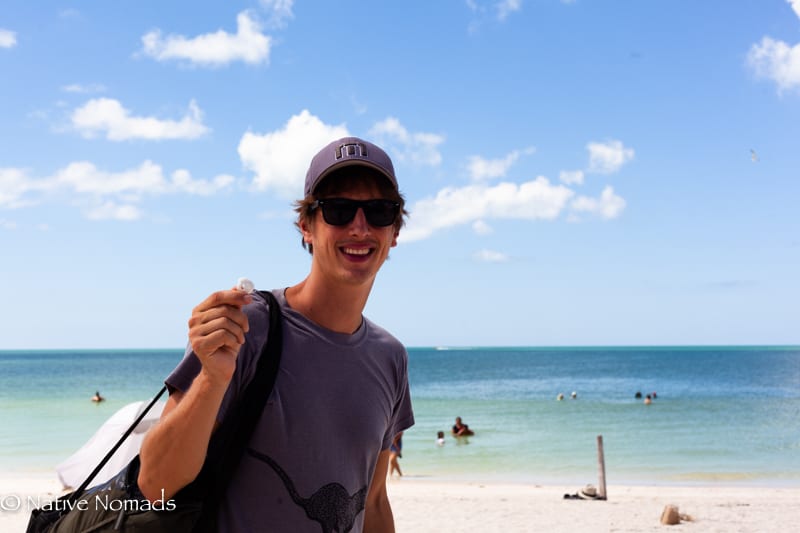
How to Get Around and What To Do Once You Are There:
There are taxis and tuk tuks (mototaxis) in town, plus a couple of places that you can rent a bike. We had rented a car but ended up walking most of the time to our destinations.

Flamingos & The Mangroves:
The unique magic of Celestun lies off the beach in the middle of the mangroves. In the open waters of the Celestun biosphere reserve are the breeding grounds for up to 40,000 flamingos. The best time to see this phenomenon is from November to March, however, the flamingos live year-round in Celestun, so really any time of the year is a great time.
There are many tour companies around the entrance of the city. We ended up taking the first option which was a center located to the left and immediately after passing the main bridge into town and it worked out great. We got to see some flamingos tour around the lagoon (from afar, they are a protected species so make sure your guide does not disturb their peace. On this side note, it would be smart to bring some binoculars). We also saw the overall biosphere, which was teeming full of life.
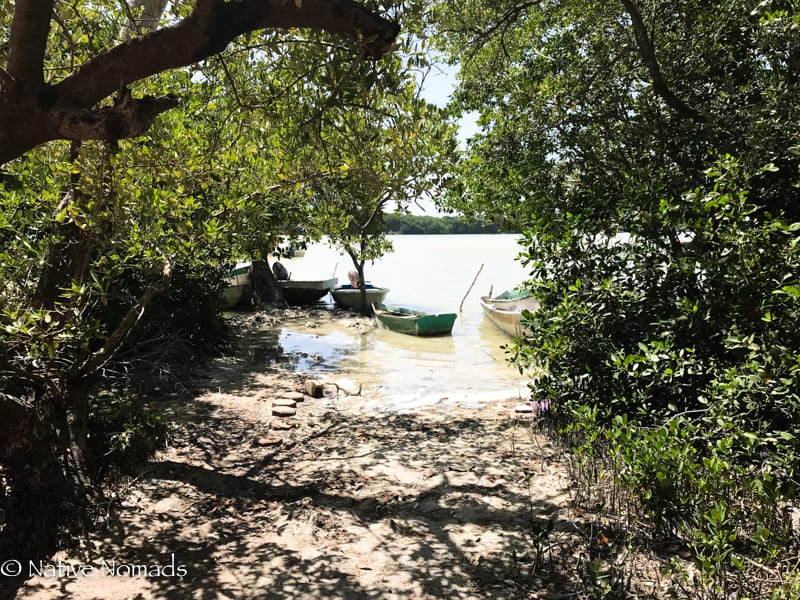

A Hidden Cenote
We also had the opportunity to jump into a sparkling, clear cenote hidden several feet in some of the mangroves, which was a once in a lifetime experience. The cenote is the most beautiful turquoise color with a ladder and a platform to jump off of.
Note: it was not until after we had already jumped in and swam around that we saw there was a local small crocodile that hangs on the edge of the cenote, which we were assured was harmless. We still aren’t quite sure if it was real or not.
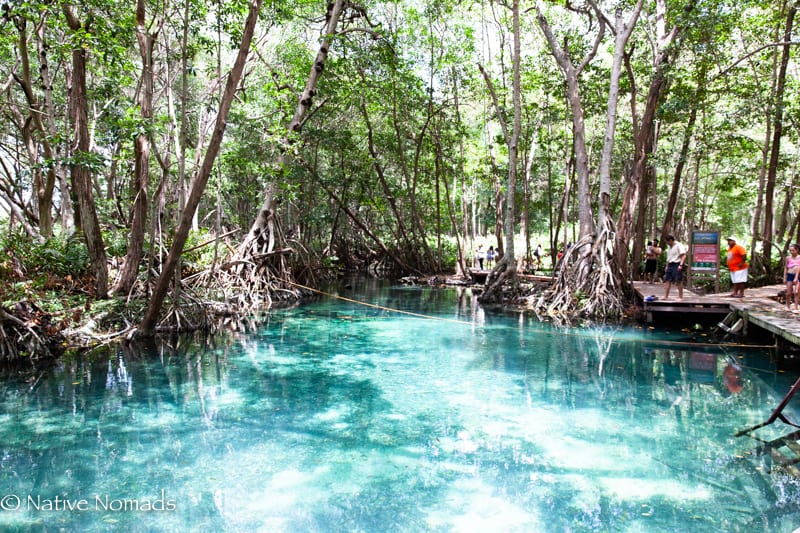
Travel Tip:
We had a great experience hiring a guide in a second mangrove tour we took there, named J Efrain Perez (pictured below) who knew almost everything about the mangroves. An older Maya man, he had been a fisherman in the village for many years but told us about how he had switched his career and devoted his life to the preservation, health and educational outreach for the mangroves and their integral part of the biosphere.
Eat fish tacos, lay on the beach, bird watch, swim in the ocean, take a boat or canoe tour of the mangroves or a flamingo tour.

Fun Fact:
The salt glands of some mangrove plants remove excess salt using ion transporters that help create a concentrated sodium solution.
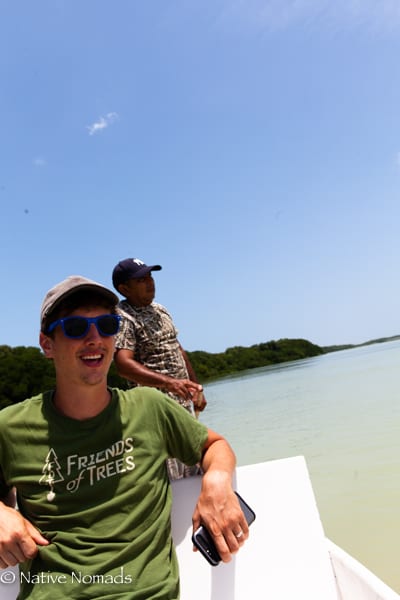
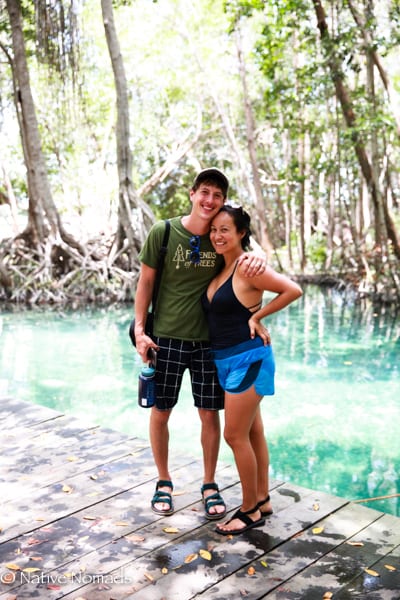
4.Ek Balam and Valladolid – Cenotes and Dinner
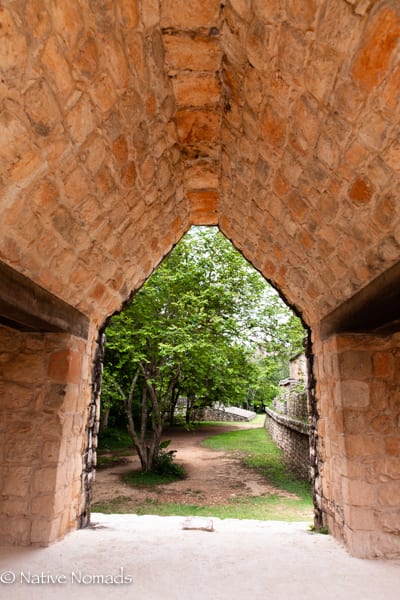
How to Get There:
Around a 2 hour drive from Merida we suggest you rent a car like most places there is enough to explore in the area that you will want the freedom to see the surrounding areas along with getting back and forth to Valladolid.

The Destination:
This is yet another one of our favorite ancient Maya archaeological sites in the Yucatan. These ruins feel like you have stepped back in time to when the Maya inhabited the village. It is wild, they have let the plants grow tall and the feel is that you are walking through a tropical jungle as you go from the ancient temple to the great pyramid (also technically called a temple) in the center of the site.
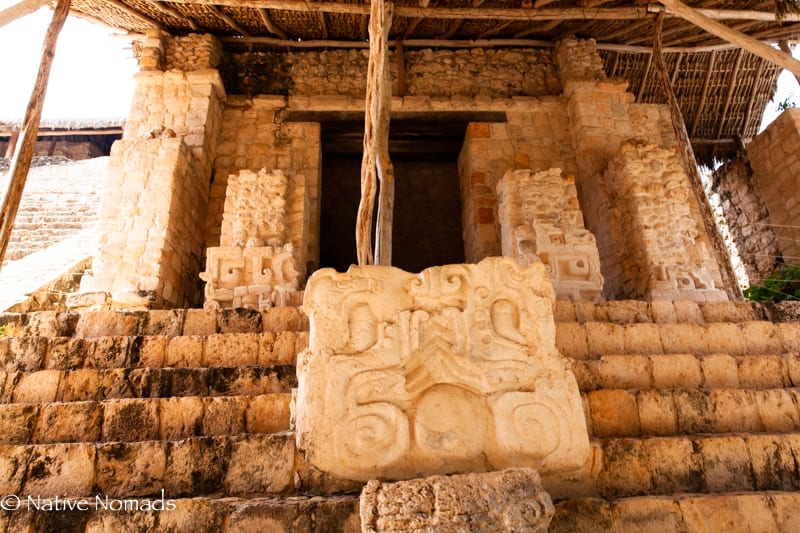
Climb to the Top
This is another site that has not restricted your ability to climb to the top of the pyramid so you can enjoy the amazing, breathtaking view of the entire area.
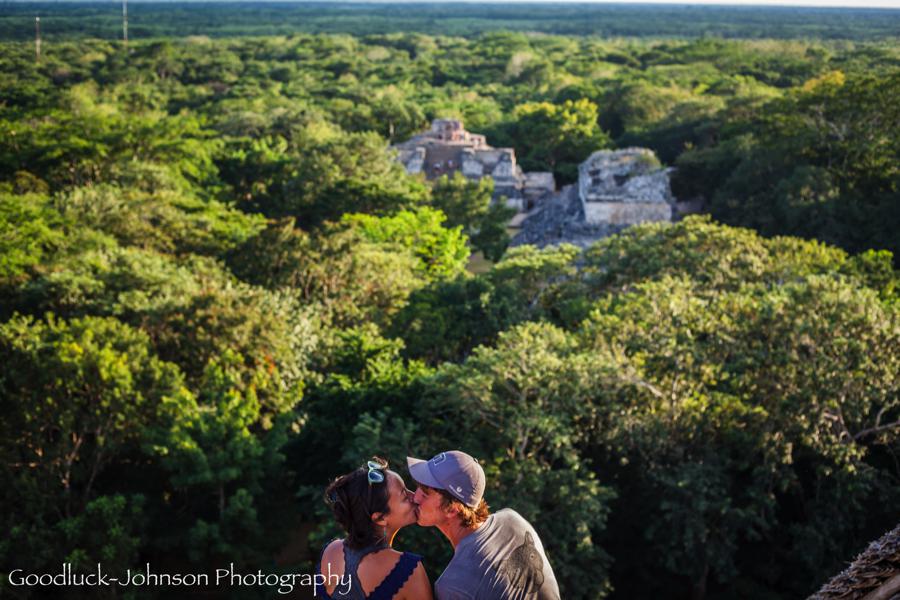

The Cenote in Ek Balam Archeological Zone:
Ek Balam is special for one additional reason: they have a massive cenote in the archaeological site that you can swim in! To get to the cenote it is a pretty far walk and since this is a single day trip, we suggest riding a bike. They have the bike rental station at the entrance to the entire site and near the beginning of the bike path. It is a great ride with the breeze to cut through the heat, and will grant you that much more swimming time. The cenote is very well maintained with clean fresh water that you can jump off a platform into, snorkel, repel off the cliffs, or simply swing from a pretty high rope swing (which we wholeheartedly recommend).
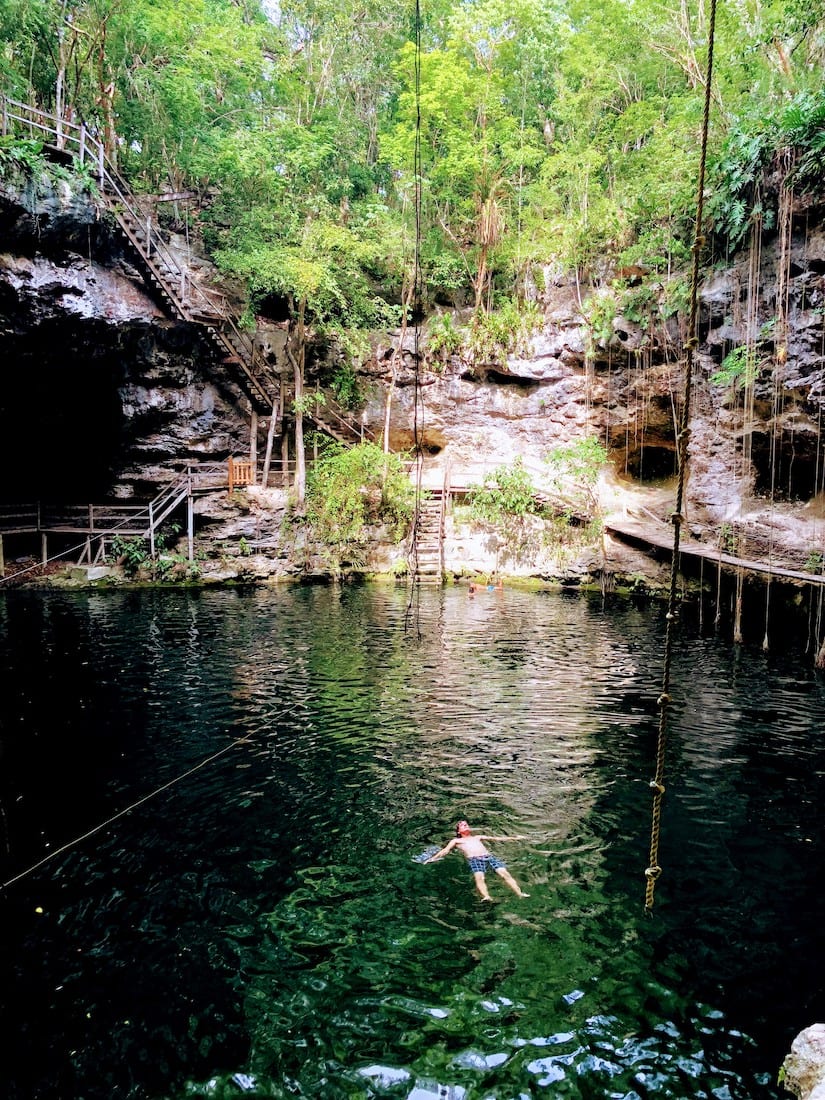
Valladolid:
Founded by the nephew of Francisco de Montejo. The city is laid out in the classic Spanish style with a massive zocalo in the middle of the town surrounded by government buildings and a beautiful church. The city feels very similar in style, architecture and layout as Merida except smaller in size. You will find many events happening often near the center plaza, with recreations of the 1847 Caste war amongst some of the regional festivities we have bumped into.
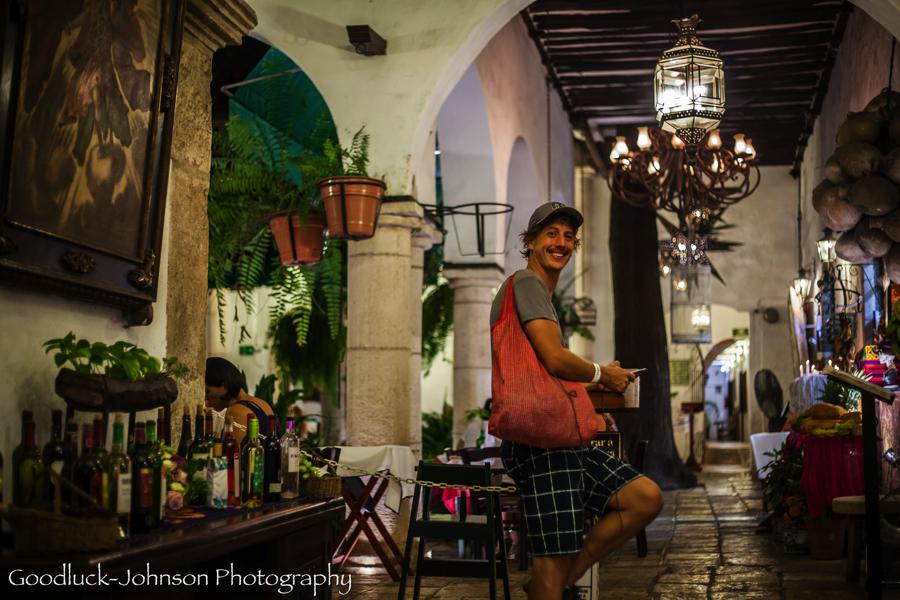
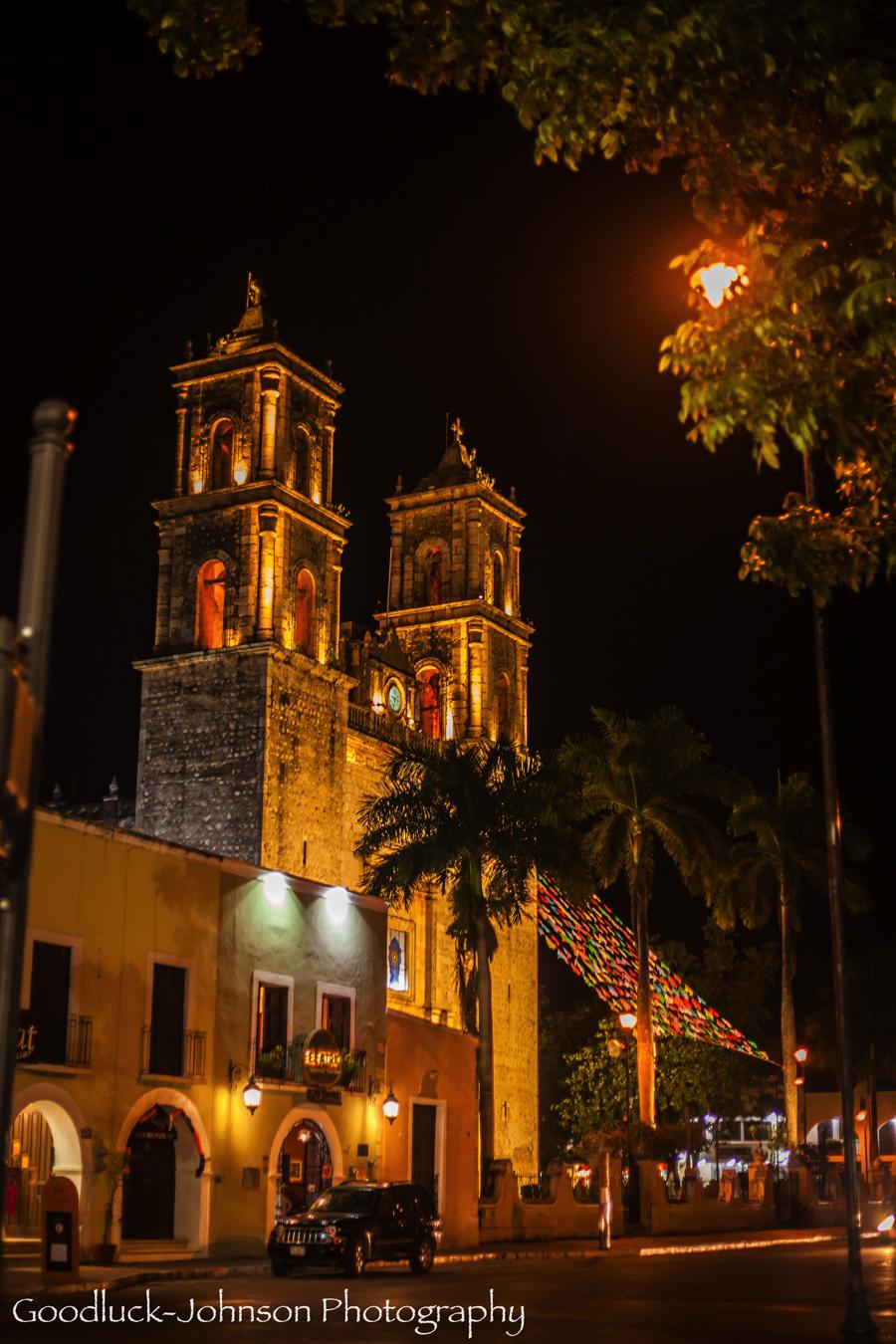
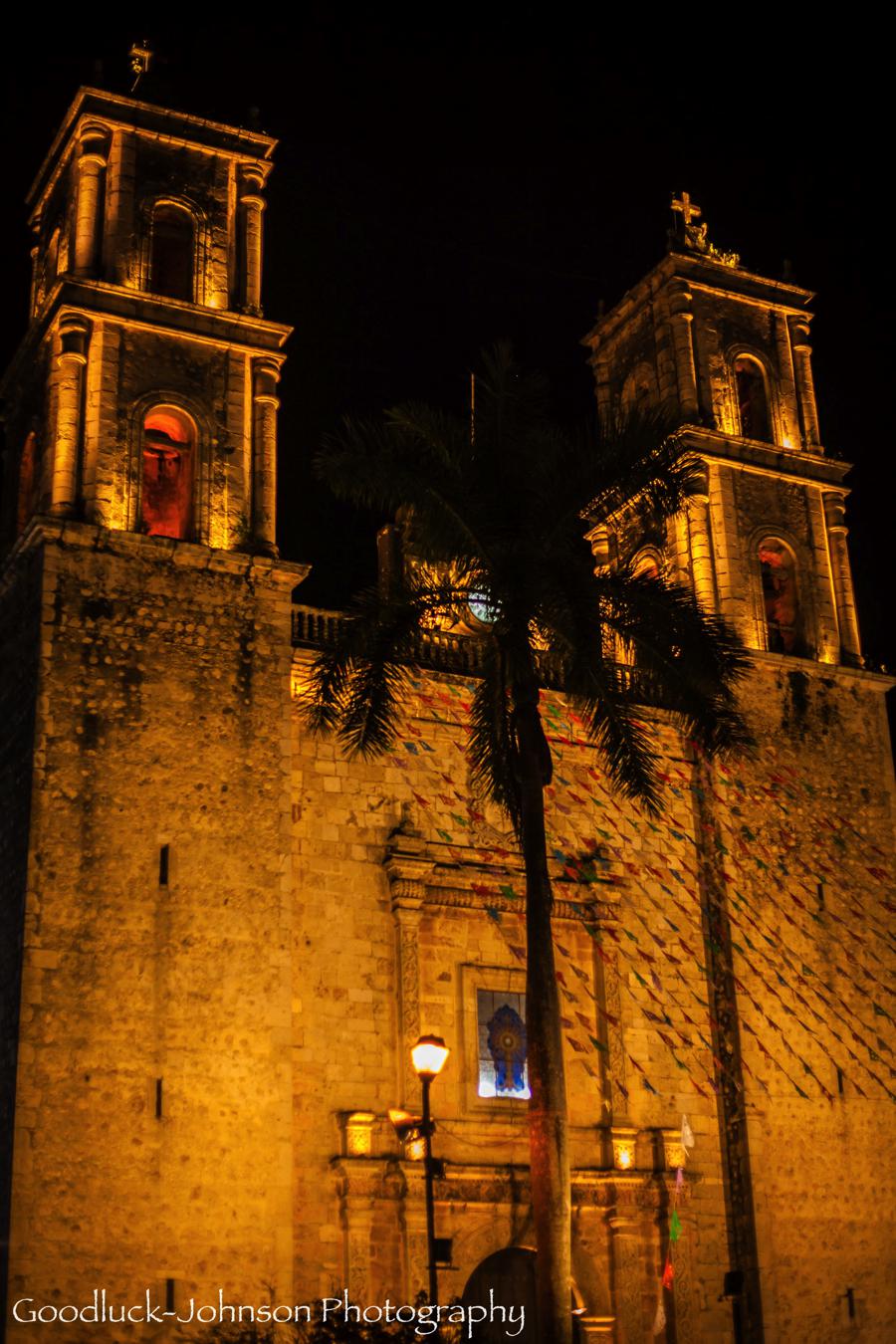
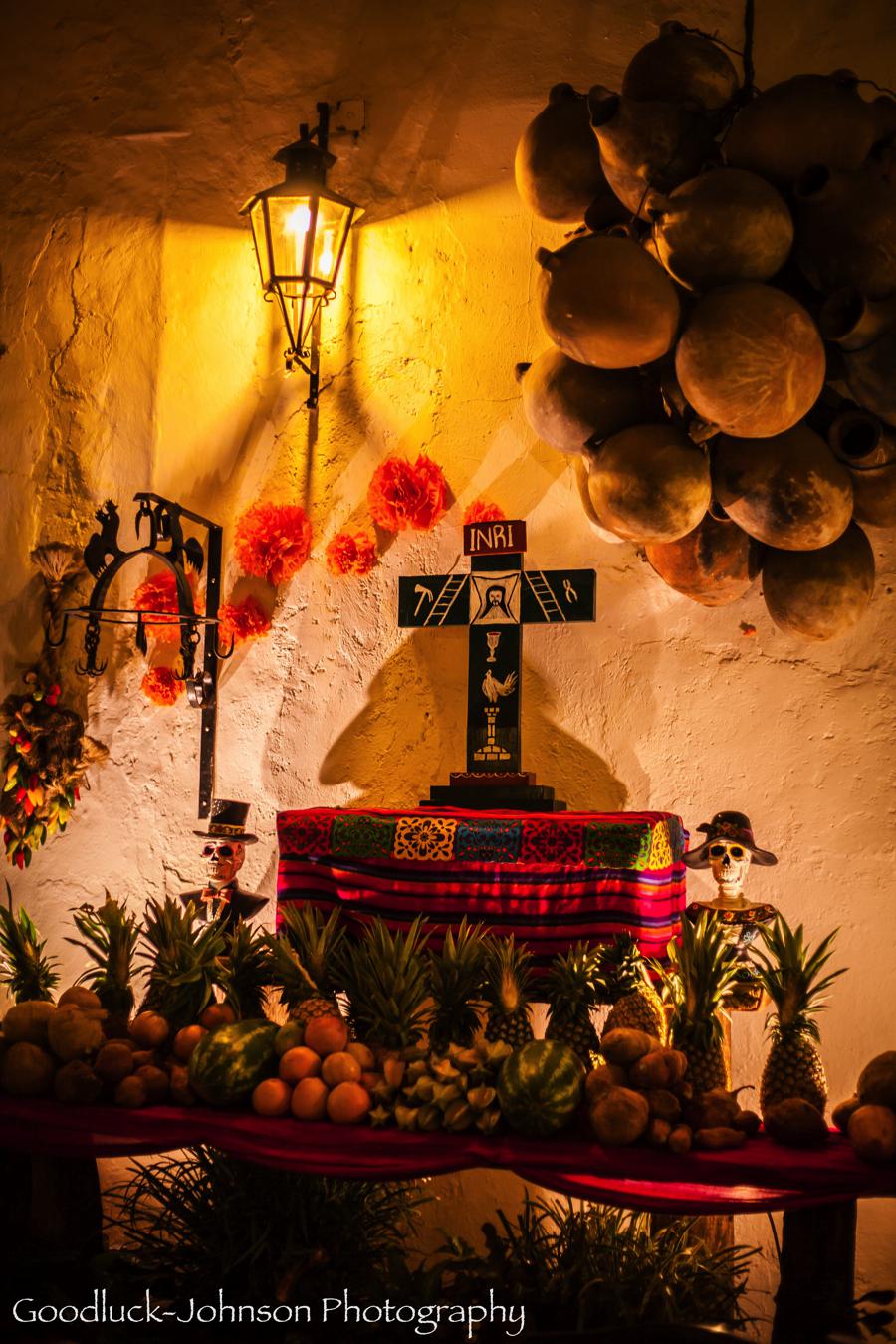
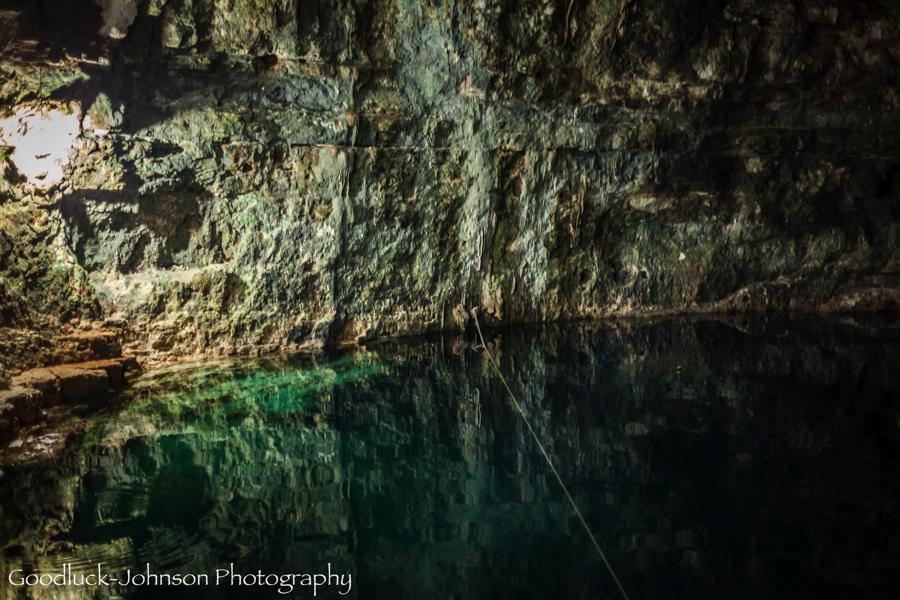
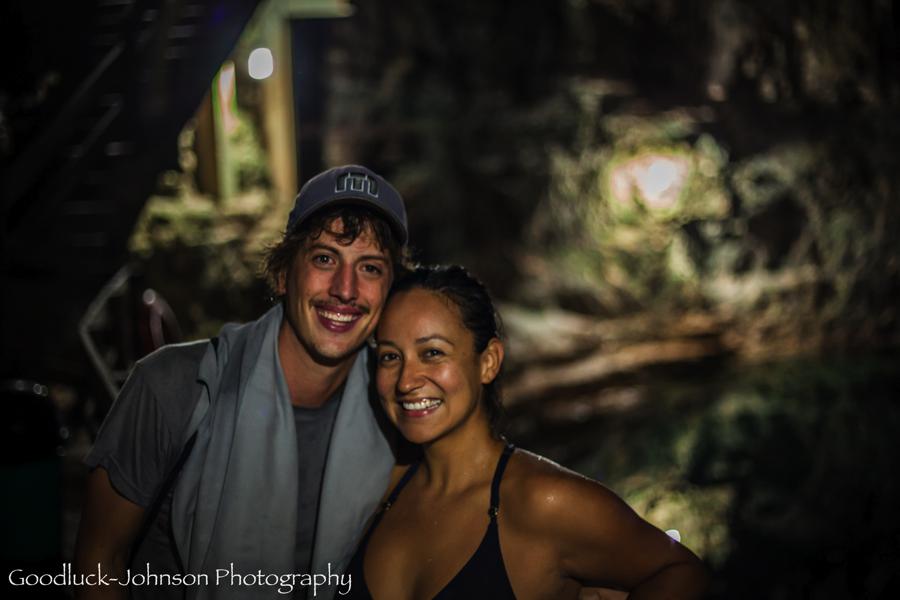
How To Get Around and What To Do Once You’re There:
The easiest way to get around the area of Ek Balam is to rent a car. This will give you the flexibility to go Valladolid (where you can further explore additional several cenotes right outside and within the city), all while traveling back to Merida as late as you would like.
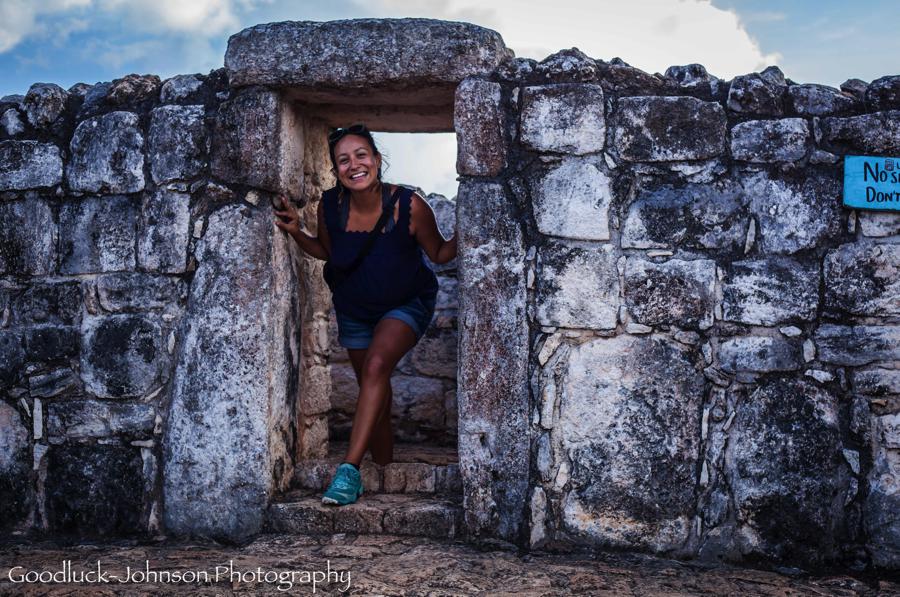
Travel Tip:
Get to Ek Balam early. It gets pretty hot in the middle of the day and there is a lot to see and read in and around the ruins. During the hottest part of the day (2-3pm), you can be gleefully swimming in the cenote while the rest of the visitors bake in the hot sun. Getting things going early also gives you more time to explore the colonial city of Valladolid afterward, which has all of the charms of Merida but feels like a more quaint version.
Fun Fact:
The entire settlement covered about 12 square kilometers but only 1 square mile can be viewed.
5. Dzibilchaltun Followed By Progresso and Oceanside Ruins
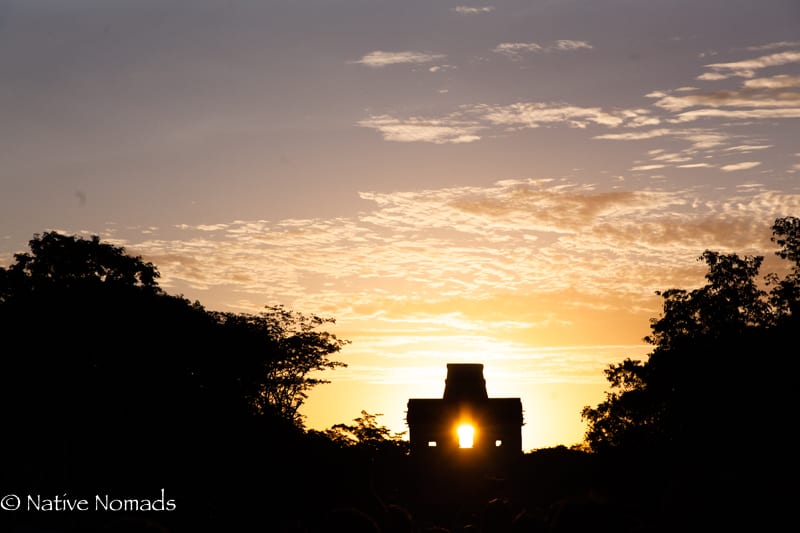
Seeing Dzibilchaltun during the Spring or Autumn Equinox at sunrise is an amazing, once in a lifetime expereince you won’t ever forget or regret getting up so early to see. Above, the sun was precisely passing through the main door of the Temple of the Seven Dolls and shining its light for all to behold this past September, 23rd 2019. We got here around 5:30 AM with enough time to buy tickets and walk from the parking lot, to the entrance, all the way through the woods and up the main path to the temple. There were a lot of people but we hear there are many more people at the Spring Equinox.
How to Get There:
The closest day trip on our list – Dzibilchaltun is just outside of Merida by 20 minutes, between the city and the Gulf Coast. You can get there by collectivo, rental car or bus. If you are in the area and are short on time this destination is perfect for the short of time.
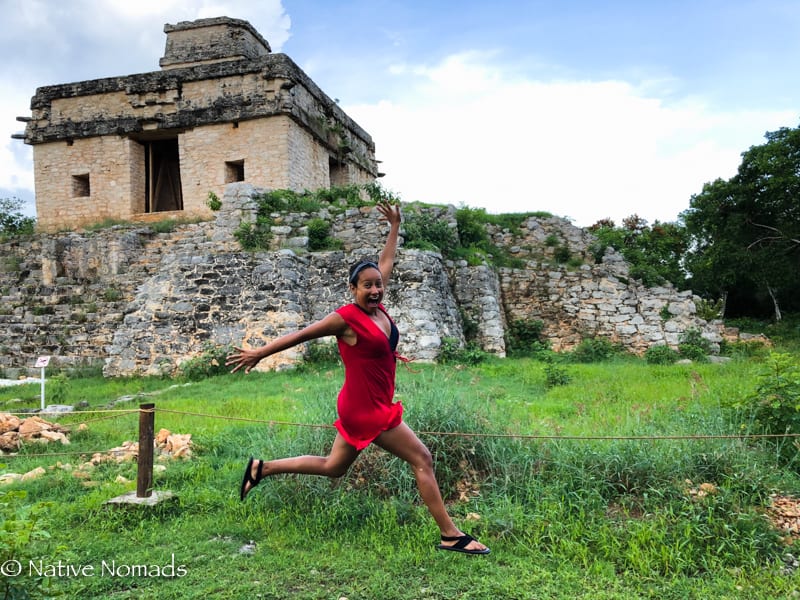
The Destination:
These are the closest Maya ruins to Merida that we have found. The ruins include a beautiful museum along with a cenote that is swimmable all year round. There are beautiful lily pads and birds landing around the pads in the center of the cenote and the water is most clear and turquoise during the spring months, before the rain has started. And again, there is the possibility to enjoy the spring and fall equinoxes at the main pyramid/temple when the sun aligns perfectly to shine right through both of the doors during sunrise.
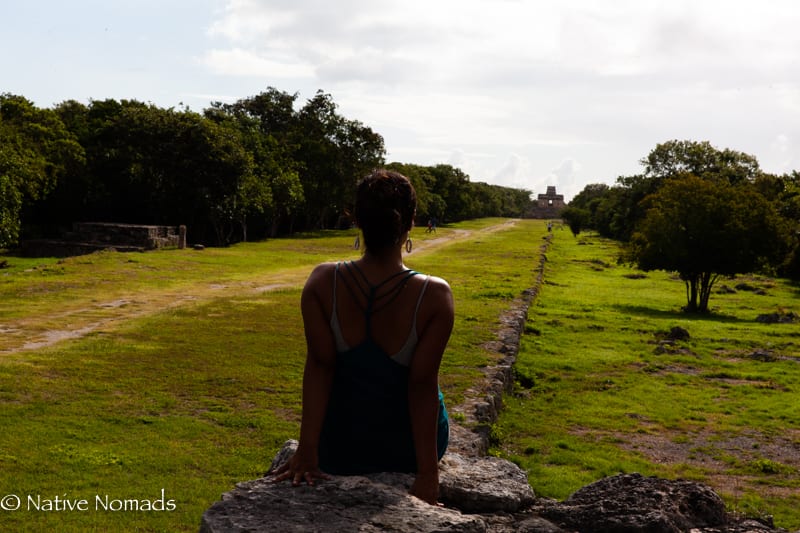
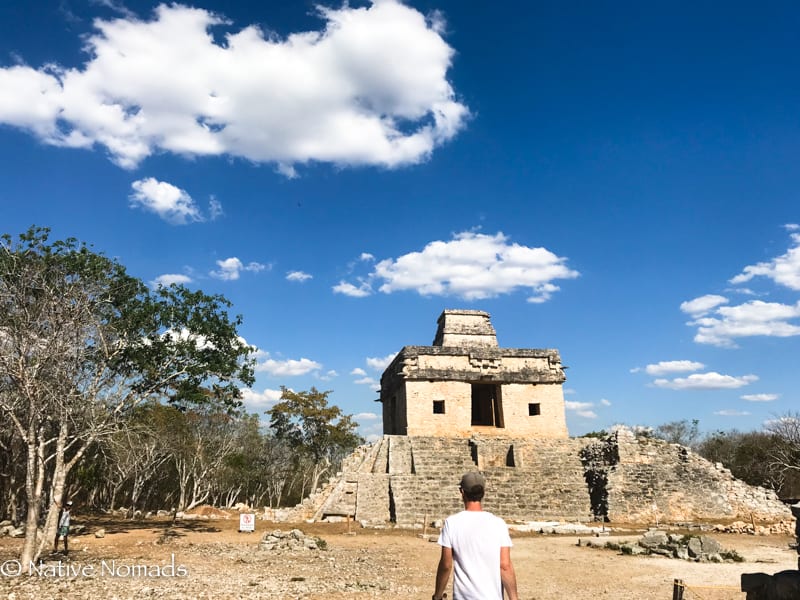
How to Get Around and What To Do Once You Are There:
If you are just going to the ruins you can use public transportation to get there and back to Merida in one day. If you’re choosing to continue your day trip to Progreso a rental car is a great option as it will give you more flexibility to see and do more in less time. Progreso is only about a 30-40 minute drive from Merida. Dzibilchaltun is halfway between Merida and Progreso, just off the main highway.

Progreso is such an easy destination to beat the heat when you’re needing some beach time and a break from Merida. We love it!
Travel Tip:
Get to Dzibilchaltun Maya Ruins early and make sure you check the weather report; there is very little shade and it can get really hot even with swimming in the cenote. Make sure you save some time for the museum and bring your swimsuit and towel for swimming. Also make sure to bring pesos (it was $150 pesos per person at the time we went but be sure to check) as they did not take credit card when we went. The site closes before 5 PM (3:30 PM was the latest to enter when we went) so call ahead to check the times.
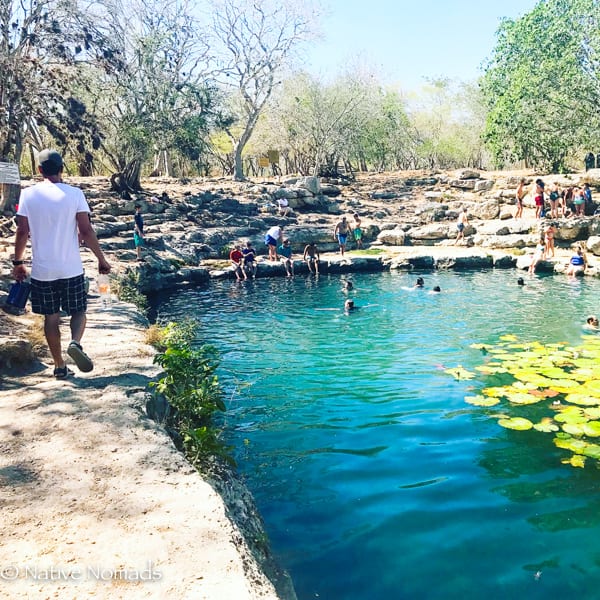
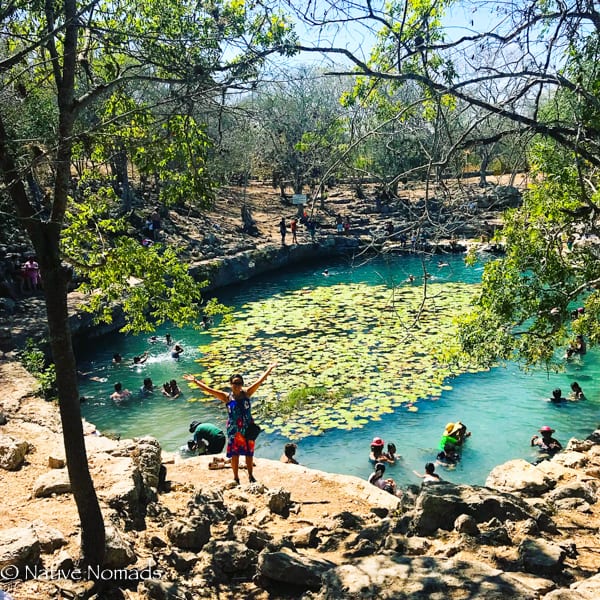
Fun Fact:
Dzibilchaltun means “place of writing in stone” in the Maya language.
6. Izamal the Golden City – Herbal Shops, Maya Ruins, Restaurants and More
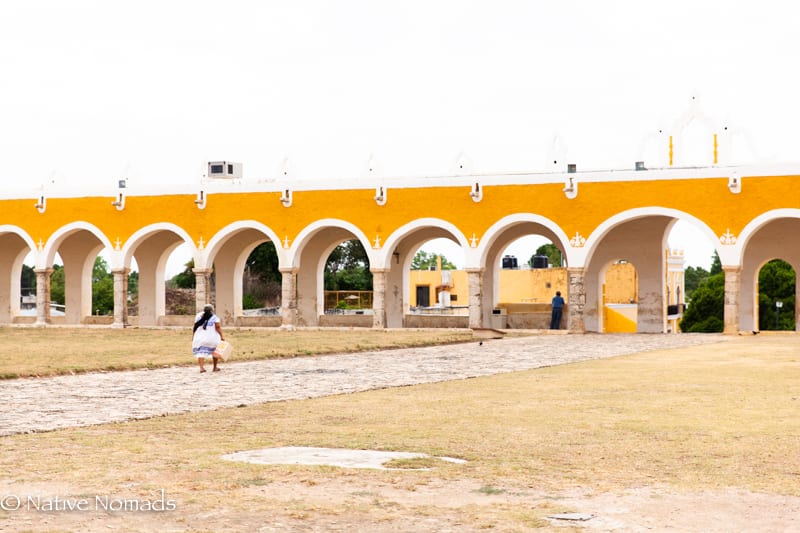
How to Get There:
There are many options for this destination from taking a bus to group tours or renting a car. We chose to rent a car because we slow travel almost everything. We love the feeling of seeing the sunset on our destination before we head for home.
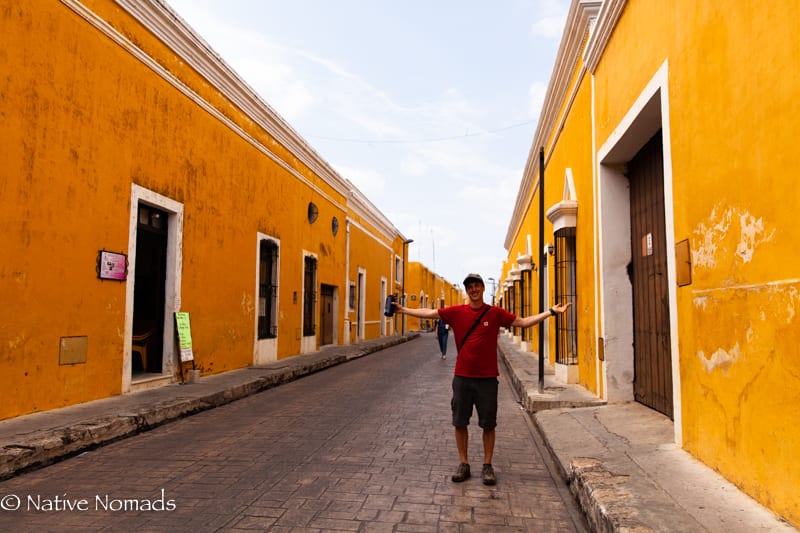


The Destination:
Izamal, The Golden City is a must-see if you are looking to find unique and picturesque locations in the world. It is part of the Pueblo Magico group of cities in Mexico and has definitely earned that title. All of the buildings in the downtown area are painted yellow with a massive cathedral in the center that has been visited by the pope.
Maya Herbalist Shop
If you walk around the city you will find a Maya herbalist shop that has a cure for almost anything that ails you. The name of the shop is: Centro Botánico La Melisa; address : x 40, Calle 38 & Calle 29, Centro, Izamal, Yuc.
Izamal Maya Ruins
If you search a little past the center cathedral you will find Maya ruins that you can climb, get some fresh air and get a spectacular view of the entire city and flat region.
Maya-Inspired Restaurant
After all the exploring you need to find the amazingly delicious and Maya-inspired restaurant called Kinich Izamal to finish off your day in this amazing city. Watch women in traditionally clad clothing make tortillas in the thatched-roof room in the middle of the palapa-style restaurant as you wait for your Yucatecan food and margaritas to come.
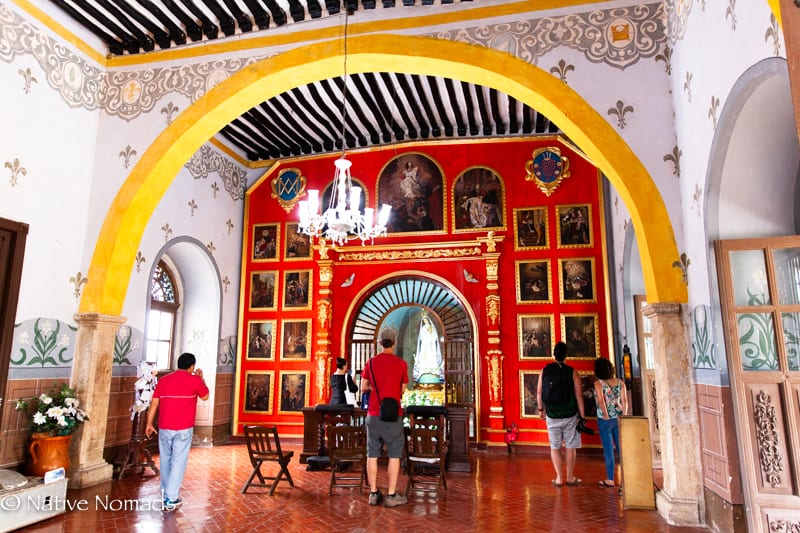
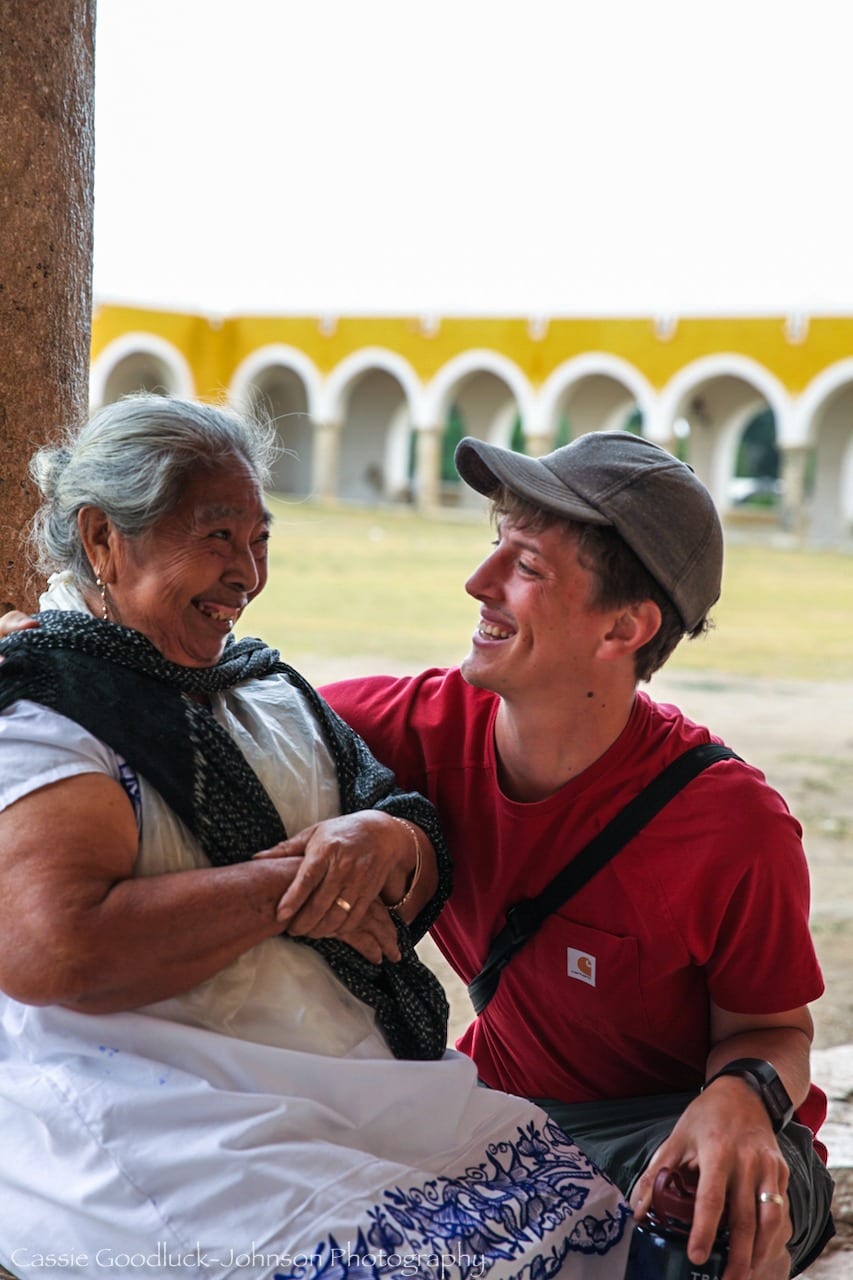
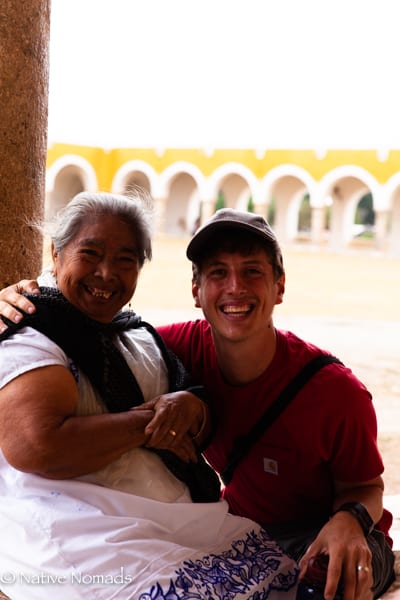
How to Get Around and What To Do Once You Are There:
Walking around the city is a great way to see everything; the streets are narrow like most European modeled cities and the traffic is very light. We found that walking around gave us the opportunity to bump into things that we would normally not see in a tourist book. Plus the photo ops are endless with pale yellow backgrounds and cobble stoned streets.
The herbalist shop, the Maya Ruins and the cathedral are the main attractions, but if it’s a nice day and the weather is not too hot, choose a direction, walk two blocks, then choose another direction and continue until you find something amazing. The city is not too large and it is easy to navigate.
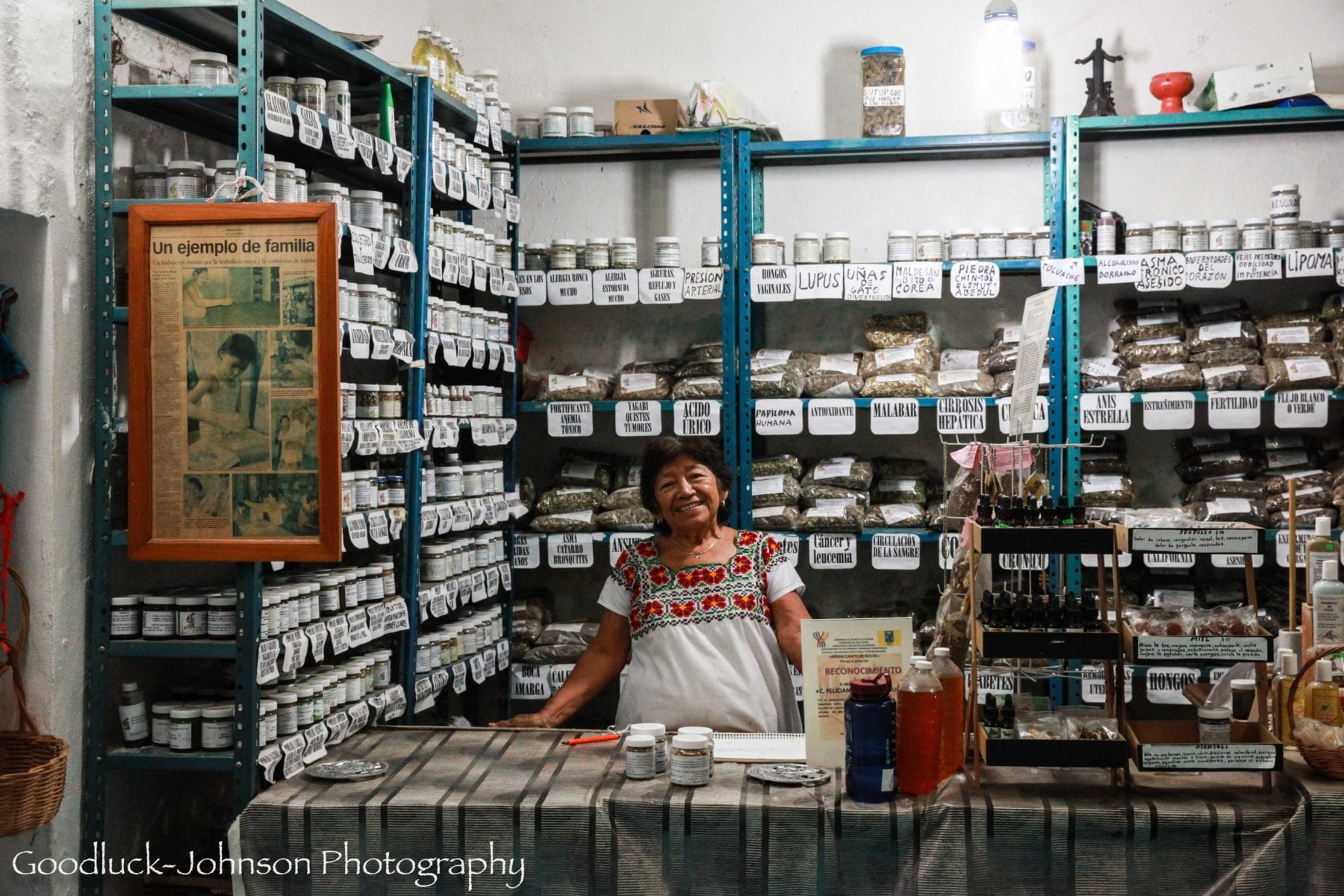
Travel Tip:
The cathedral is a great place to start and walk around and the admission for the museum is very low. However, walking over to the ruins is our number one travel tip along with the Maya inspired restaurant where they make their tortillas fresh, right in front of you.
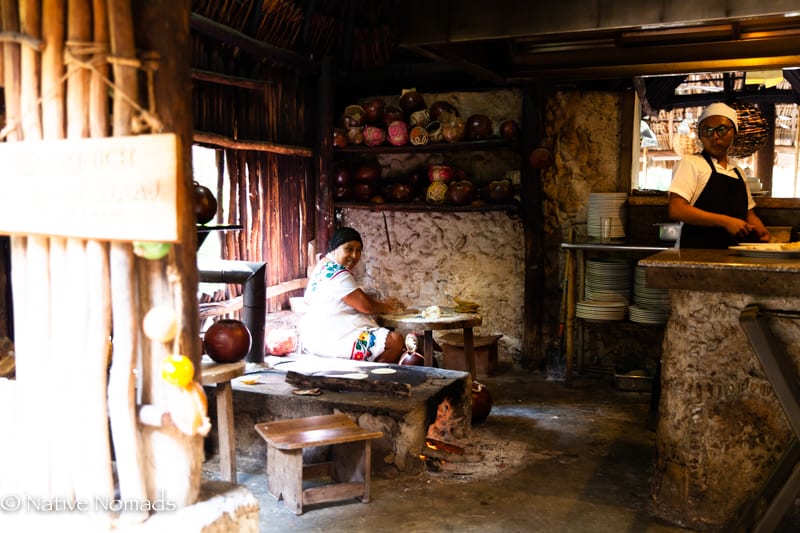
Fun Fact:
Izamal has been a pilgrimage site where Maya people offer respect to Kinich Kakmo, a sun god. You can see this reflected in the town’s distinct yellow or gold color of the houses in the center of town.
7. Ruta Puuc with Loltun Caves
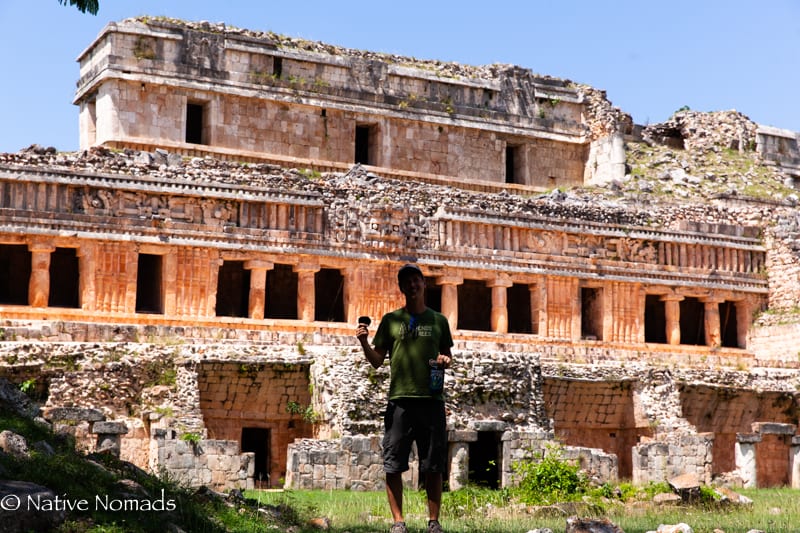
How to Get There:
There are great tours that leave from Merida that will take you along the Ruta Puuc, which is a route of Maya cities all leading into one another, which are now in archaeological ruins. Uxmal is the biggest and most famous one. Buses might be a little tricky on this one as there are many stops and you would probably spend the entire day waiting for the next bus. We rented a car and took our time moving through the multitude of different ruins which also includes the Loltun Caves or Grutas. The area is slightly hilly which was a nice departure from the typically flat rest of the Yucatan Peninsula.
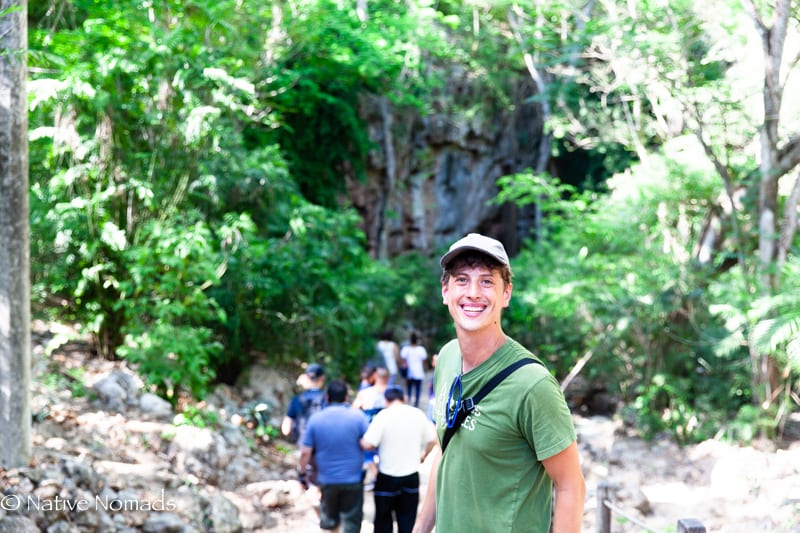
The Destination:
Ruta Puuc is a loop through the Yucatan that brings you from one ancient Maya city ruin to another ancient Maya city ruin. Each one has its own charm and history. All of them boasting some of the most detailed, intricate and sophisticated of Maya architecture and adornment of buildings. You will see Maya pyramids (or “temples”), administration buildings, ball courts, palaces where the elite dwelled, water catchment systems (“cisterns”), that rival what we use today, as well as many other religious and nonreligious structures for housing and prayer.
Chaac, the rain god is prevalent in all of the structures, with his toothy open mouth, spiral eyes and long curly nose. We are sure the Maya prayed to Chaac for rain every chance they got as this is a more arid region of the Maya empire (a large range of city-states) stretching from the modern day Yucatan Peninsula down to Chiapas (a Mexican state), Guatemala, Belize and the northern part of Honduras.
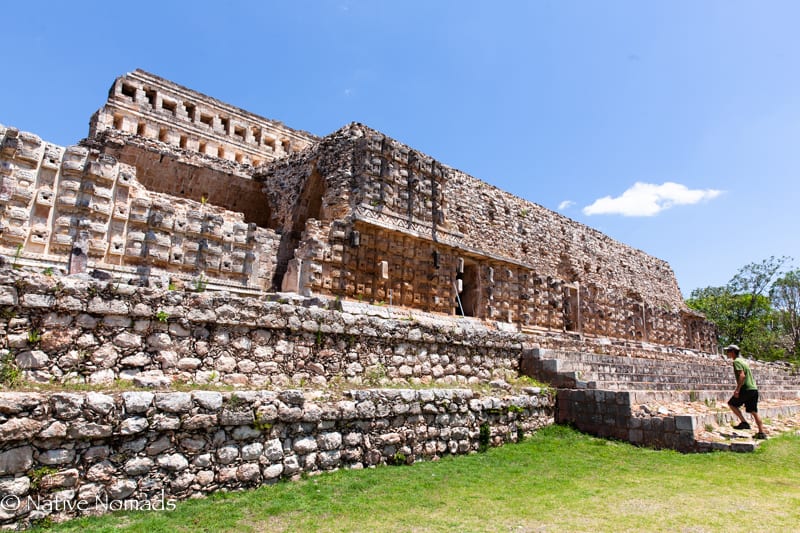
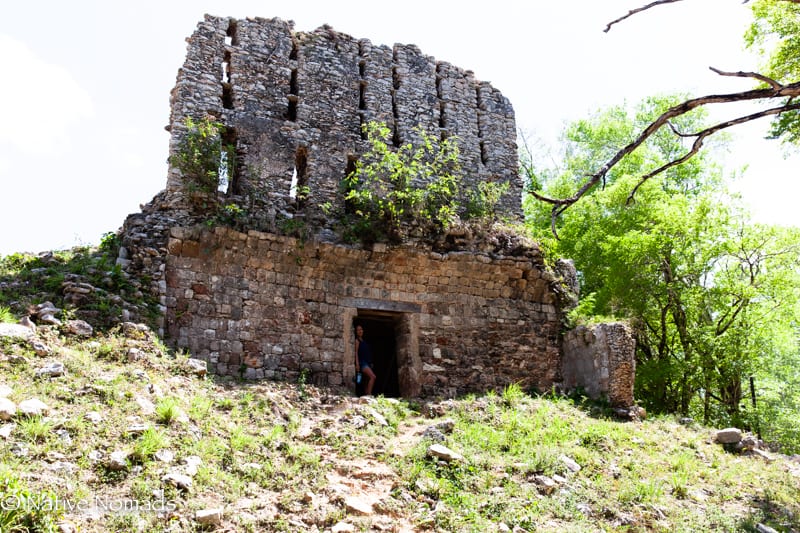
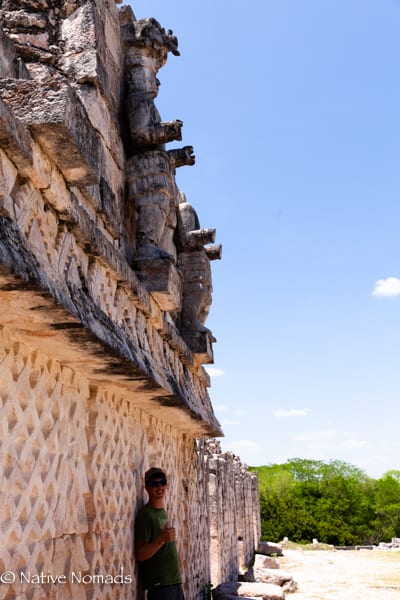
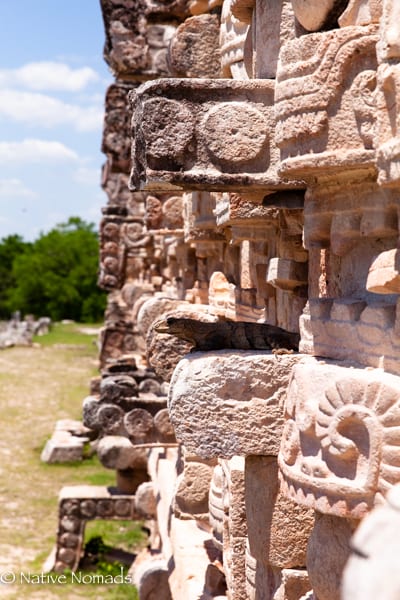
The Loltun Caves (“Grutas”):
They are part of an extensive ancient cave system that was used by the pre-Maya as a place of dwelling in the time of the saber tooth tiger. They used the cave system at first as a form of protection (from said saber tooth tiger).
Later, during the classic Maya periods, they used it as a sort of pilgrimage and religious spot to hold ceremonies and pray and communicate with their distant ancestors. At the end of the tour (which is mandatory that you hire a tour guide), you will see a blackened handprint on the wall that was carbon-dated back to 10,000 BCE during the time of the saber tooth tiger. That was a pretty epic and once in a lifetime thing for us to see. The massive cave system is lit up during the open hours with neon lights that highlight parts of the cave and makes mysterious and beautiful photographs for later.
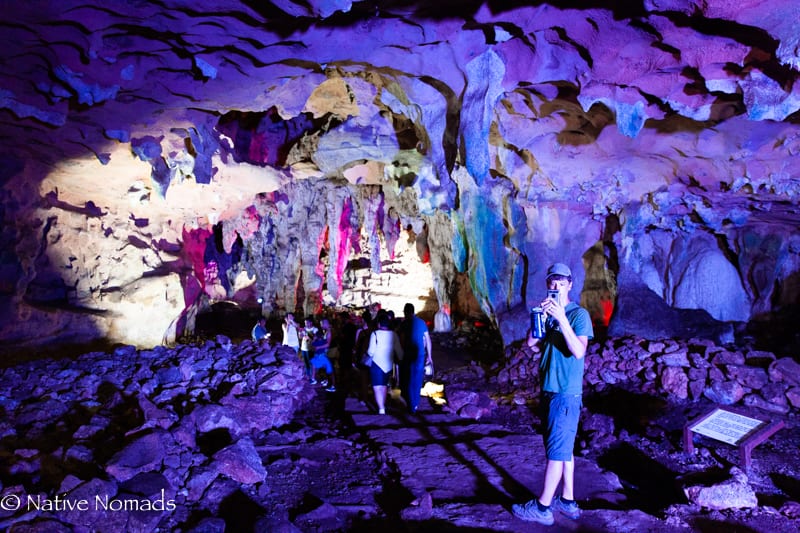


How to Get Around and What To Do Once You Are There:
Hiring a tour or renting a car is the best way. The caves are not set up for people that have trouble walking and the ruins typically have a ton of steps, so make sure to wear a good pair of sturdy shoes, plus bring sunscreen, a hat and plenty of water.
Spend time exploring all of the many ruins and explore the Loltun caves.
Here are 4 less-known Ruins on the Puuc Route to check out along with Uxmal:
- Labna
- X-Lapak
- Kabah
- Sayil
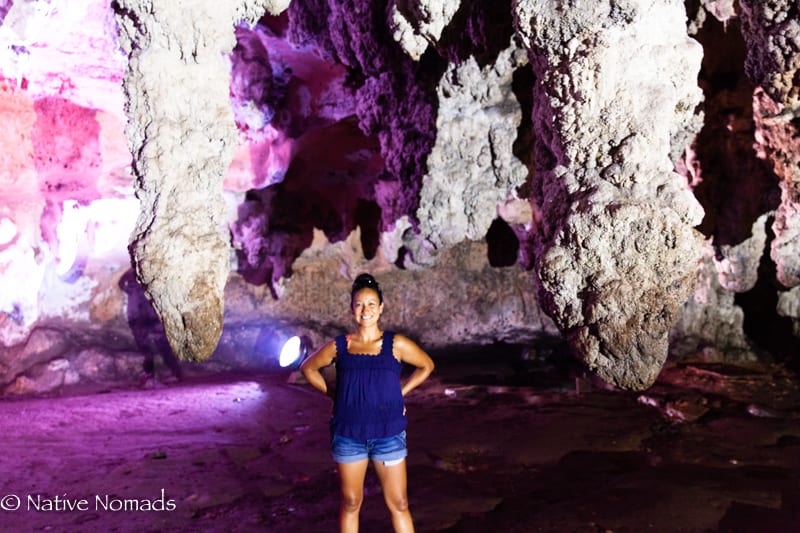
Travel Tip:
Get an early start as most of the ruins and the Loltun caves close early (around 5pm) and you should try and see as much as you can. Hire a guide when you go to Lultun Caves and make sure they show you the 10,000 year old handprints from ancient Maya dwellers.
Fun Fact:
Mammoth, bison, feline and deer bones have been found in the caves or grutas, along with fresco paintings on the walls.
8. Chichen Itza & Ik Kil Cenote
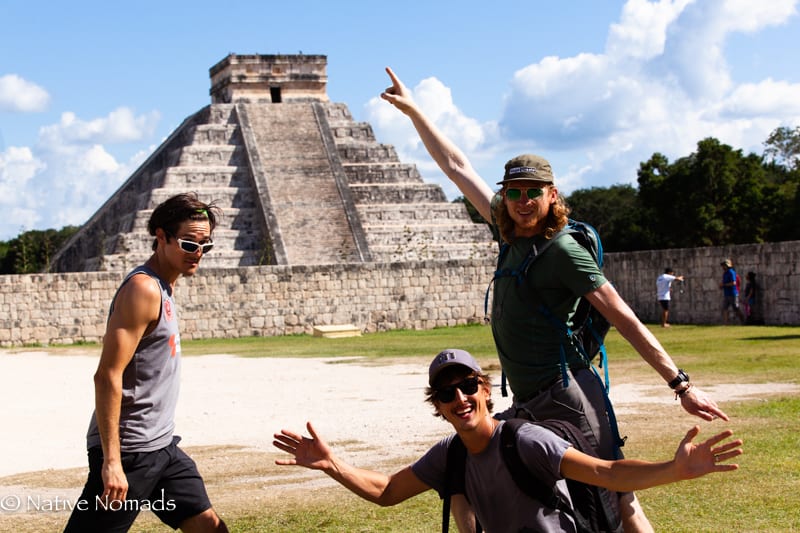
How to Get There:
One of the most famous Maya sites in the world, there are multiple tours a day that leave Merida and will bring you straight to Chichen Itza. It is one of the major destinations in the Yucatan Peninsula and you can also find buses that will bring you straight to the ruins. We have always appreciated public transportation, with a single destination area, however, a rental car is a great option to take your time and explore the area’s cenotes after seeing the ruins and most likely being very hot.
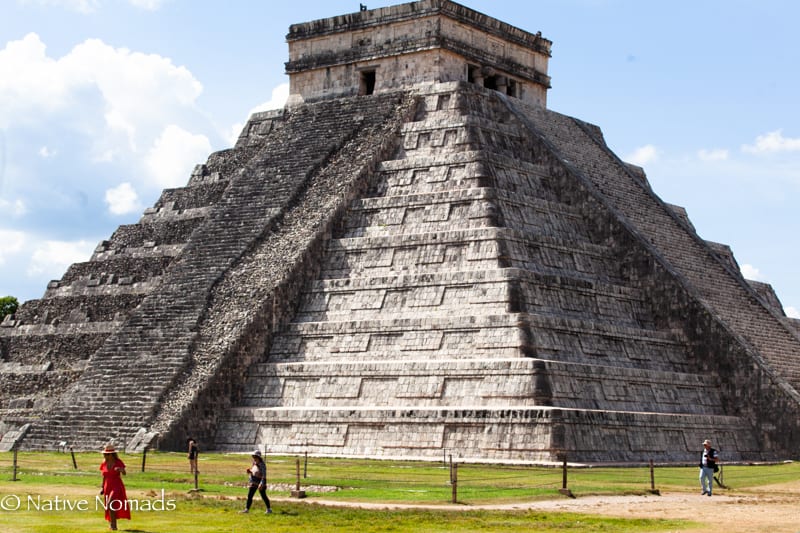
The Destination:
Chichen Itza is one of the main tourist sites in the entire Yucatan Peninsula. It is a wonderfully restored glimpse into the past of how the Maya administration, royals and religious people lived in the area. It has a large pyramid (or temple) in the center that is not climbable any longer due to what they say was a fall down the ancient steps by a tourist, plus vandalism sadly. But the pyramid is a great wonder to see (as well as one of the wonders of the world).
It is worth it to clap at the base to hear the echo all around you. During the spring and fall equinox, the sun casts a shadow in the form of a snake down the zigzag edge of dozens of steps going down the corner of the pyramid. Chichen Itza is always busy but this is definitely one of the times it is the busiest. Take your time and explore the ruins, which have more rustic parts at the edges of the site that are overgrown with the surrounding tropical forest. The trees are a nice respite from the blazing sun. Also take your time to see preserved, colorful frescos (paintings) inside some of the buildings, which display Maya scenes similar to Roman ancient frescos. You will also want to spend some time exploring the gigantic ball court which a good guide will tell you about the ritual ceremonial games that were played there. It’s pretty epic.
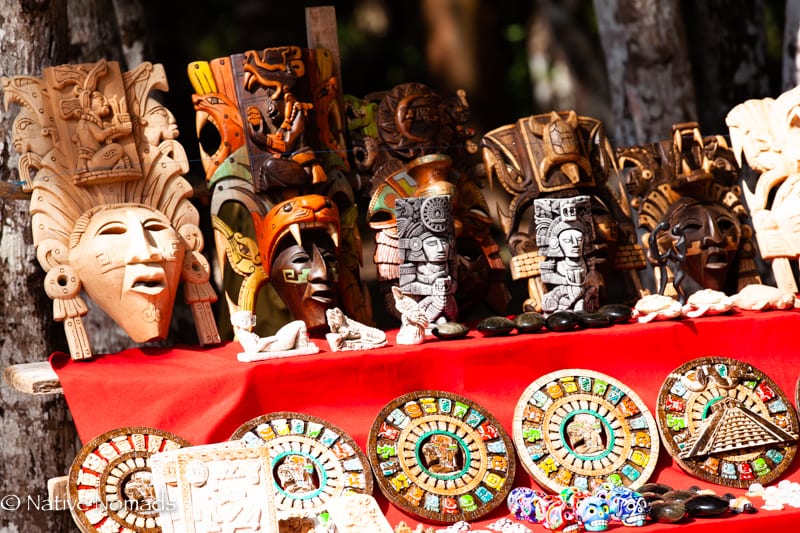
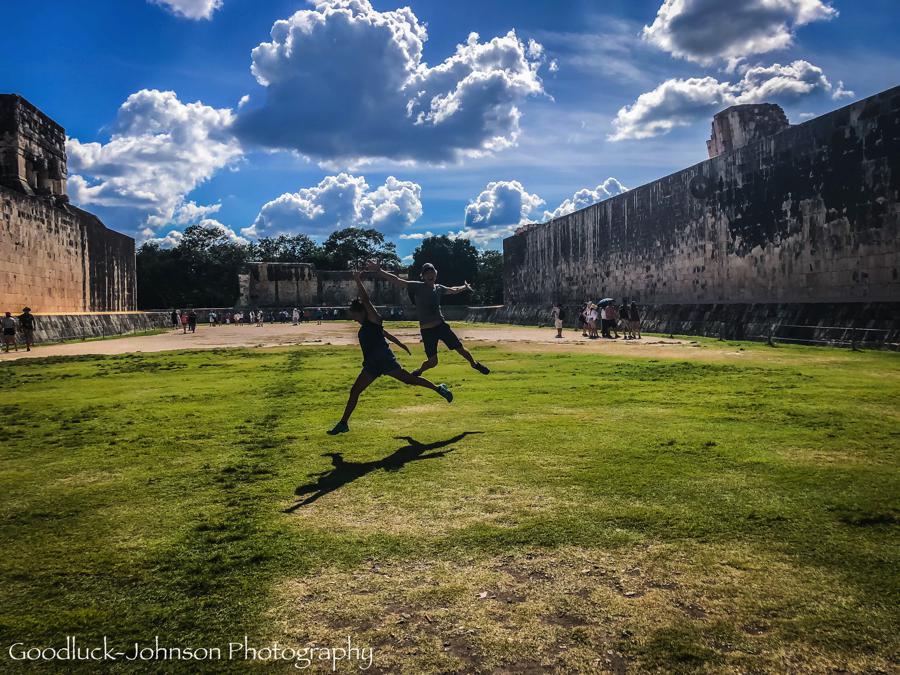
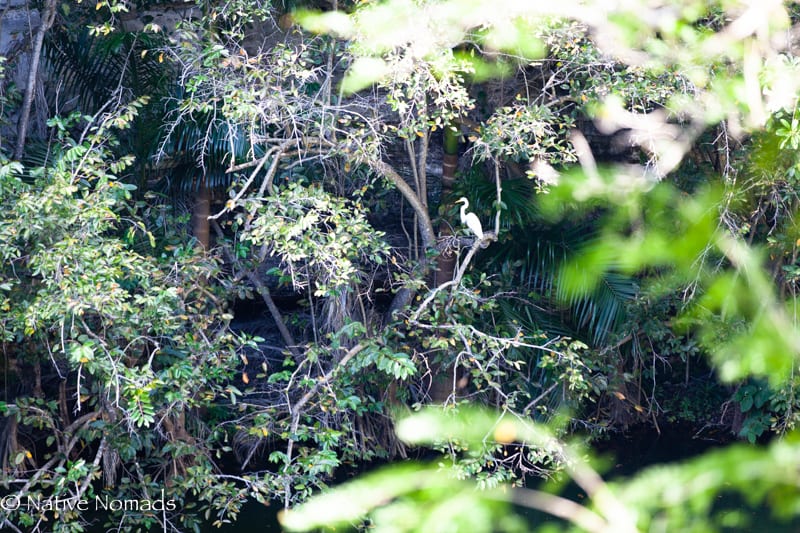
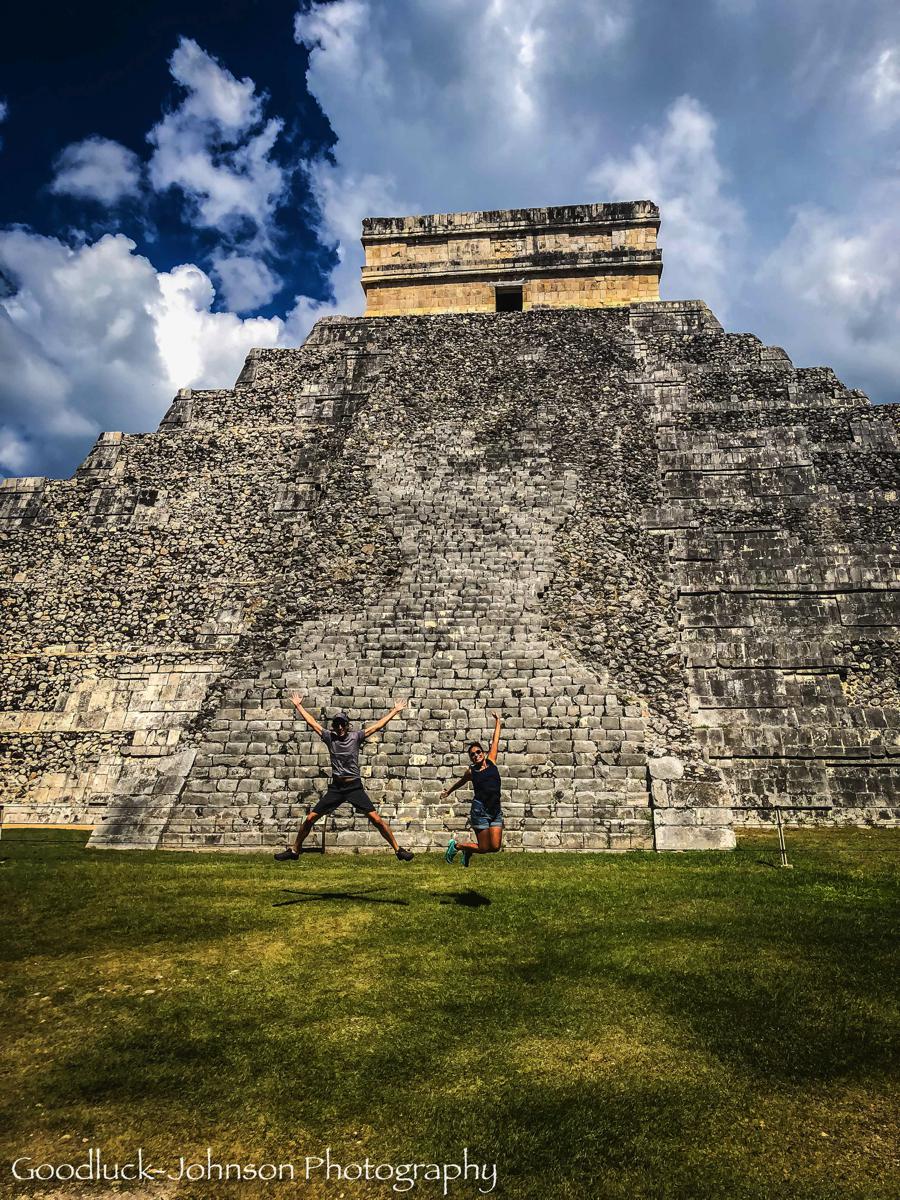

How to Get Around and What To Do Once You Are There:
Make sure to bring a hat or a sun umbrella along with sunscreen and water. Like most archeological ruin sites there is a lot of sun with little to no shade. To get around the ruins there are not a lot of other options than to walk.
See the ruins, along with visiting the cenote at the archaeological site (it is unswimmable) which is located down the path past the main pyramid. Also check out the observatory, the ball court and the wall of skulls.
Swim in Nearby Ik Kil Cenote
If you are able to get around or you are on a tour make sure to go to Ik Kil cenote, which was the home to the red bull high dive competition one year. The cool refreshing waters of Ik Kil, plus the gorgeous view of the sky, vines growing down into the large pool and the many birds flying around the limestone rock all around you, will heal you after a long hot day in the sun.
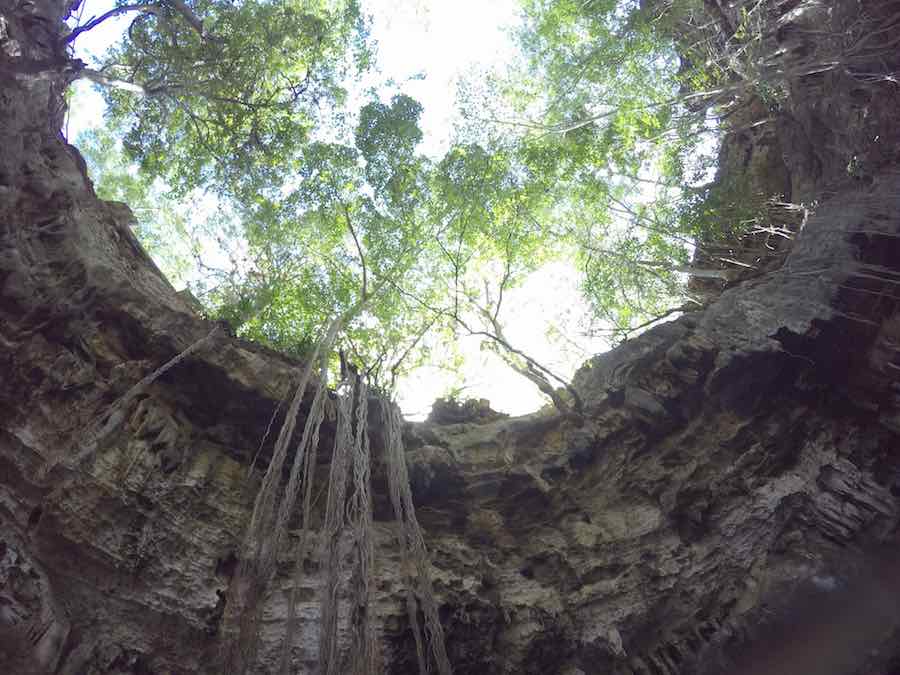
Travel Tip:
We hired a tour guide our first time and we loved the inside knowledge he had of the ruins. We learned a lot about the ancient Maya and their beliefs and way of life as well as the history of the excavation and restoration of the site. Make sure if you are in the area during the equinox to check out the shadow from the pyramid at the right time.
Fun Fact:
Chichen Itza is considered to be one of the Seven Wonders of the New World.

